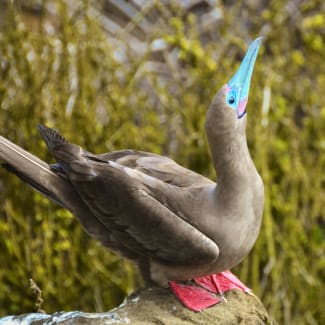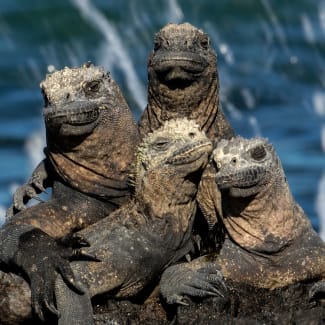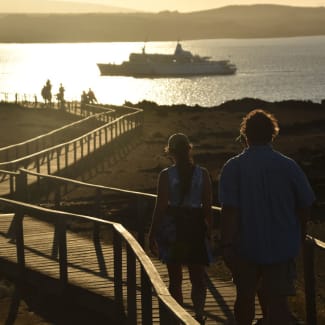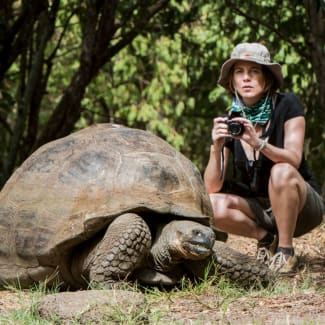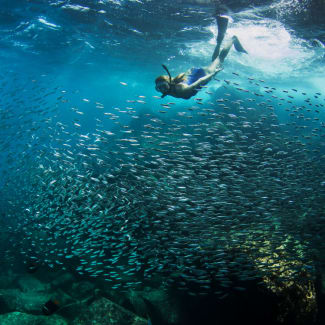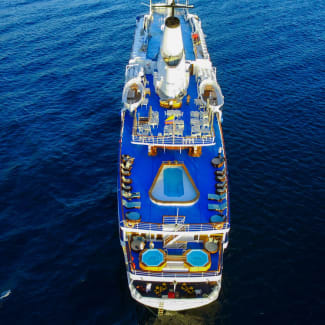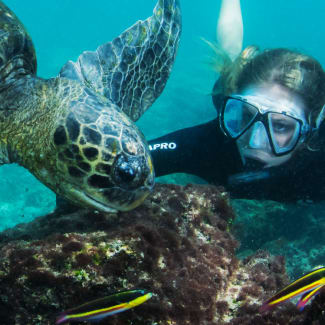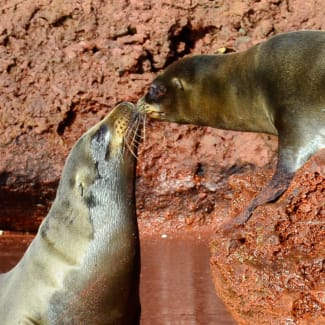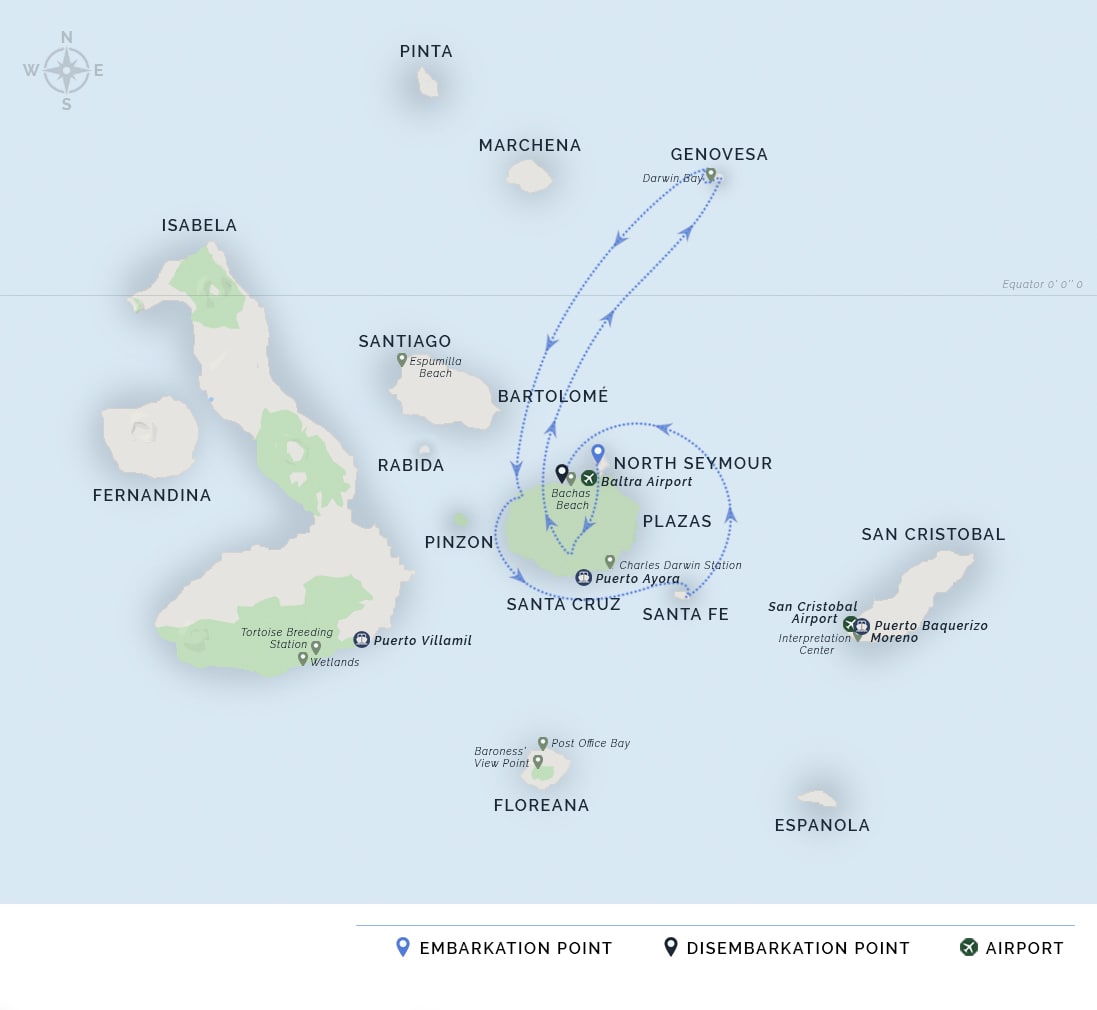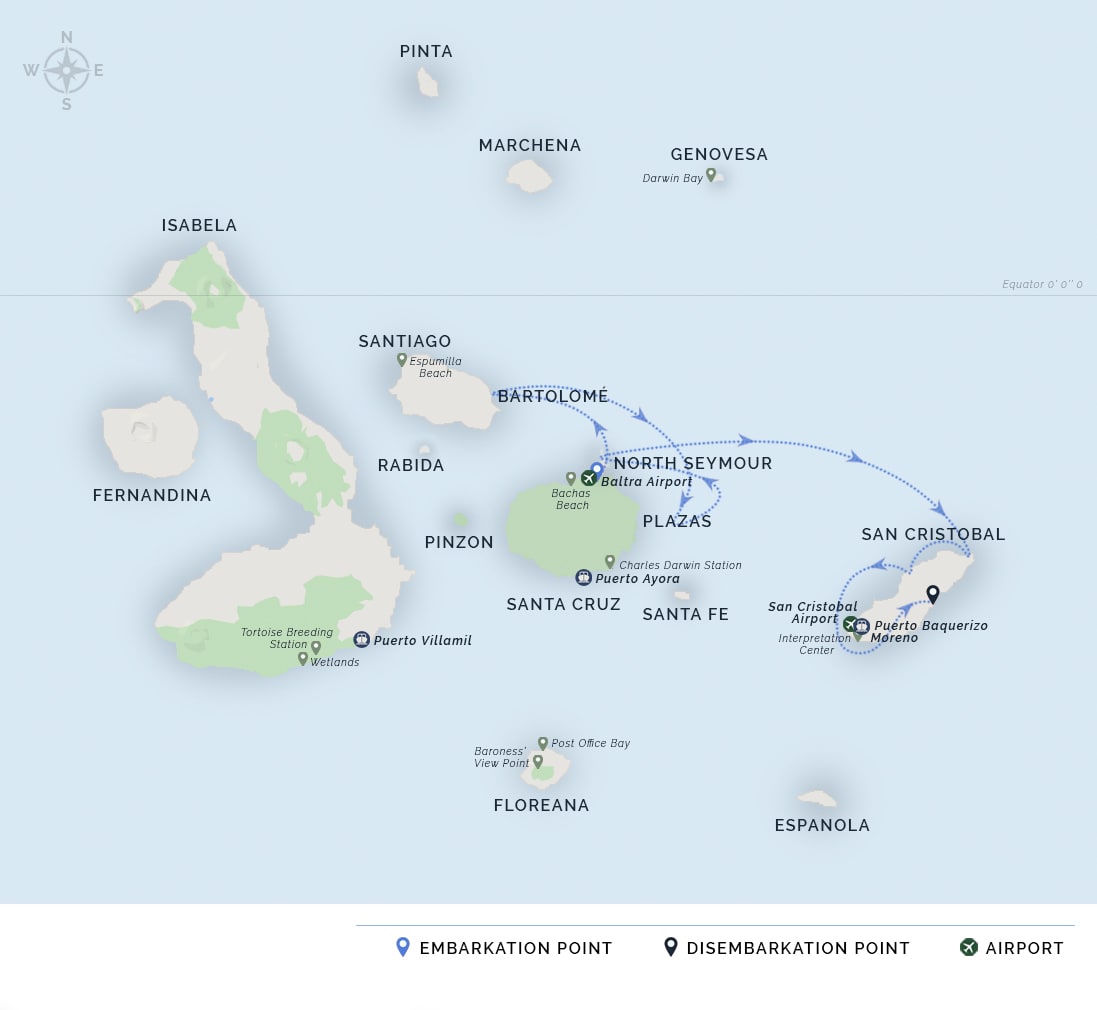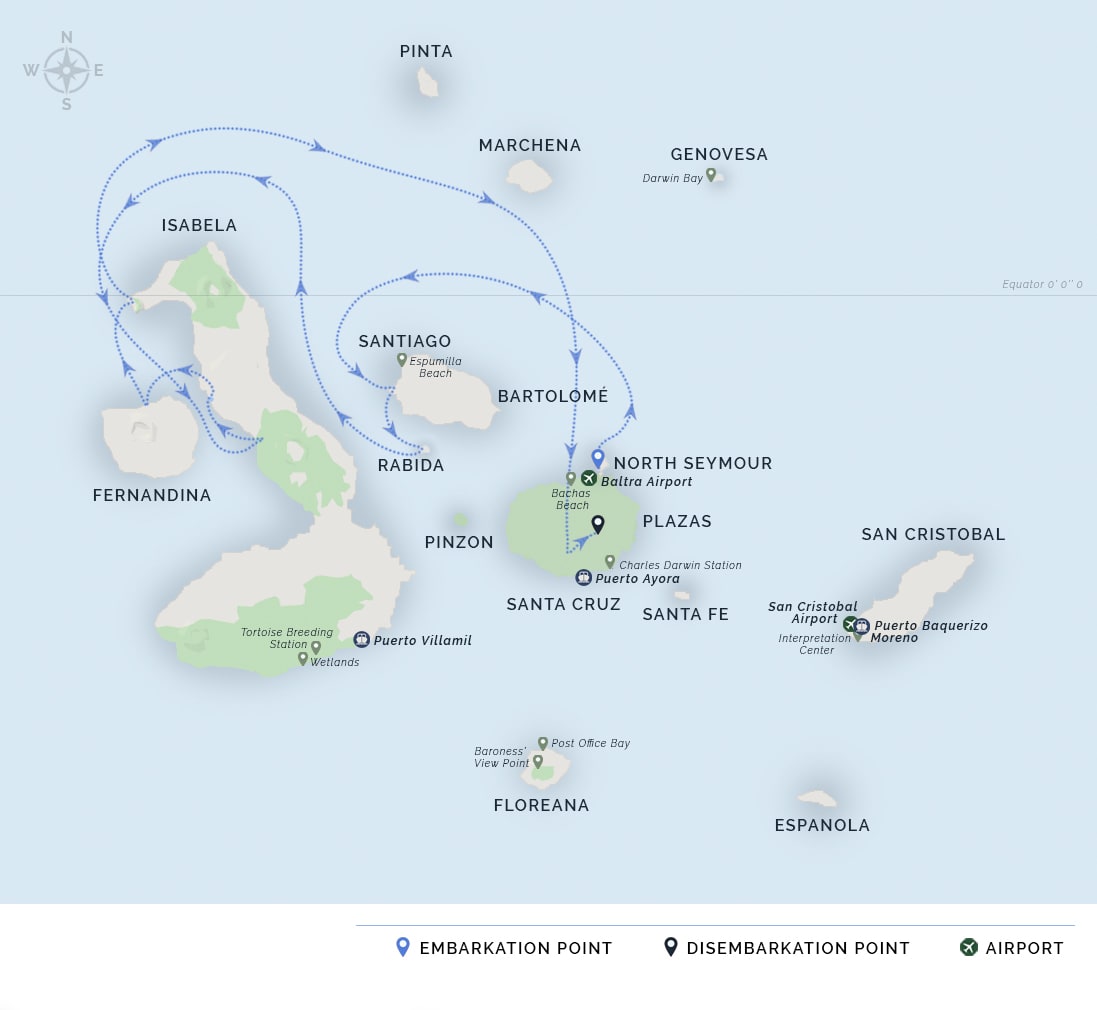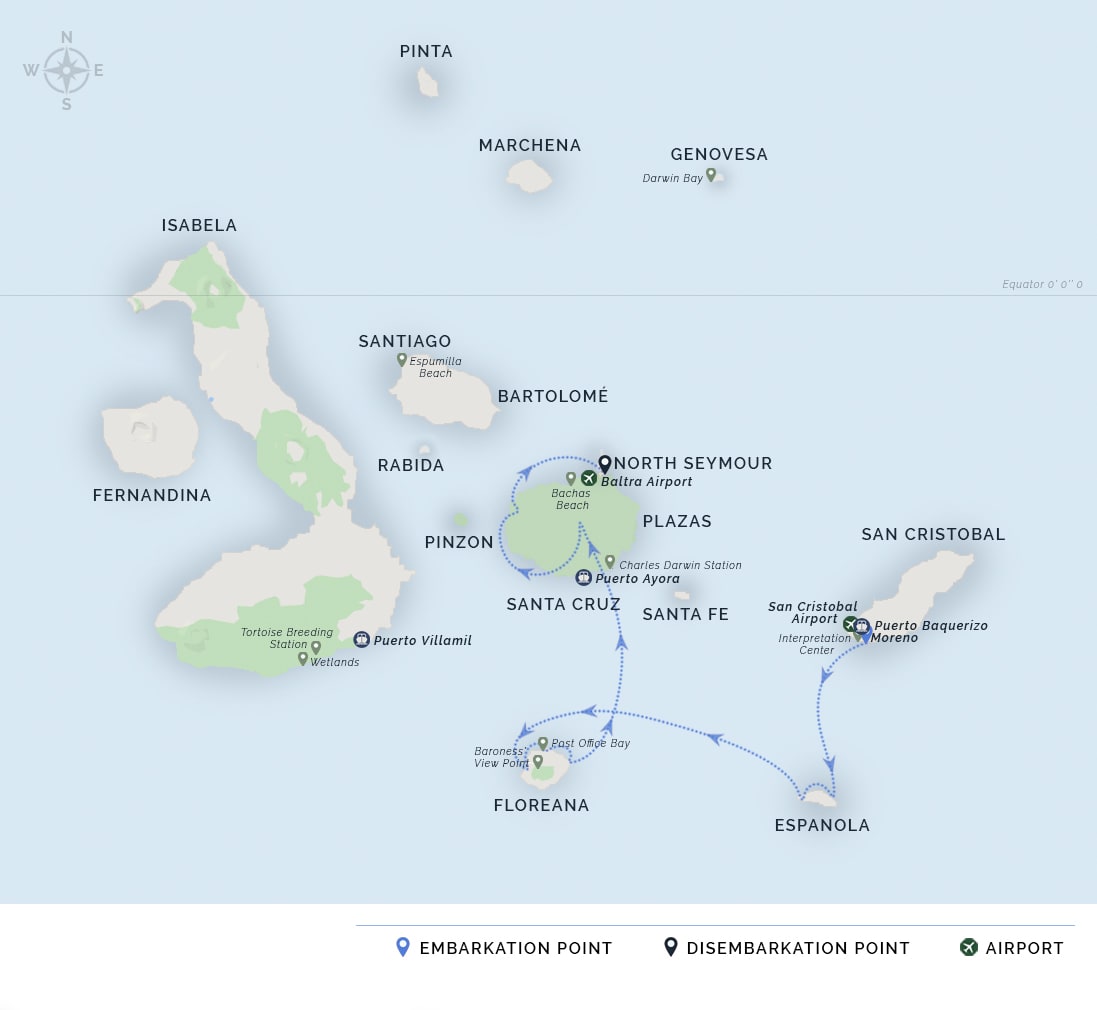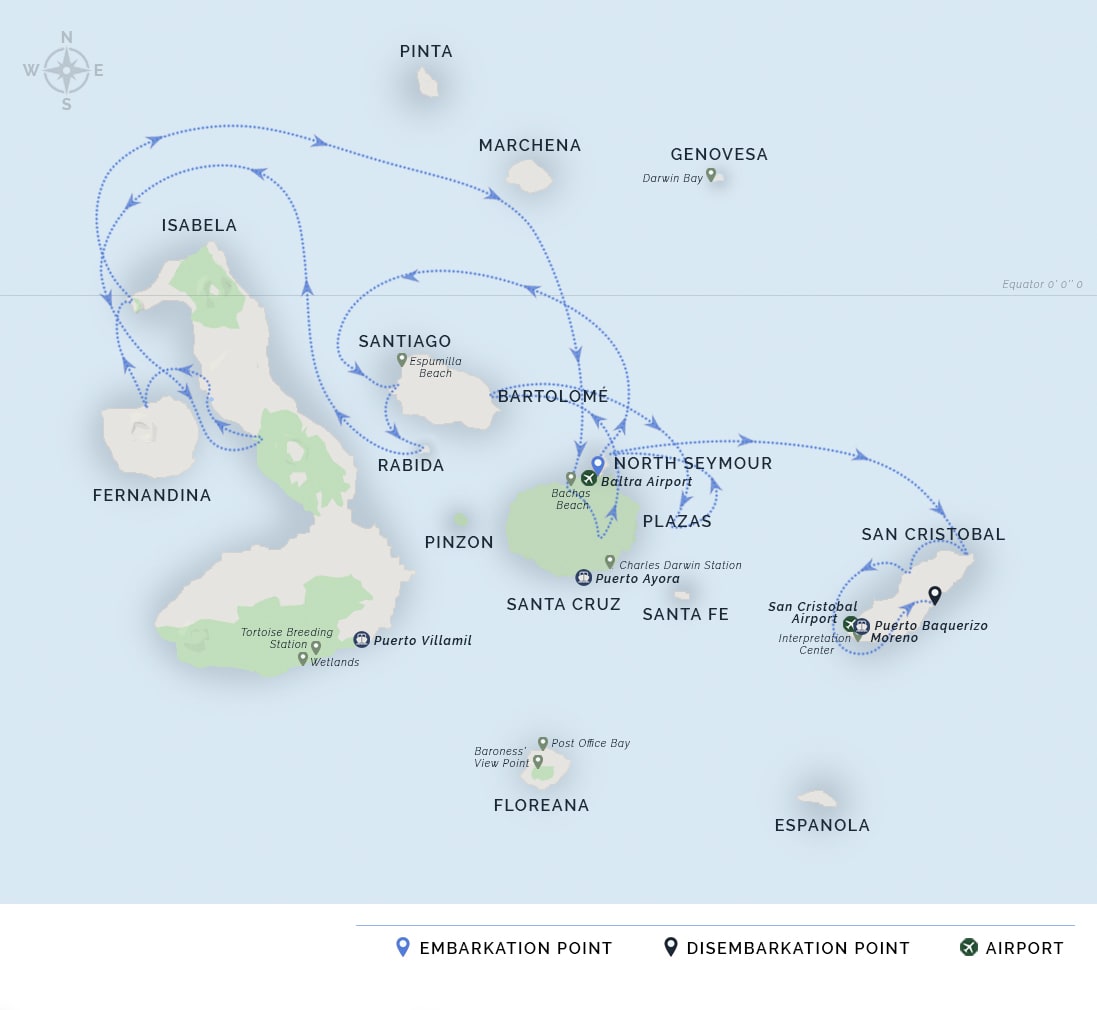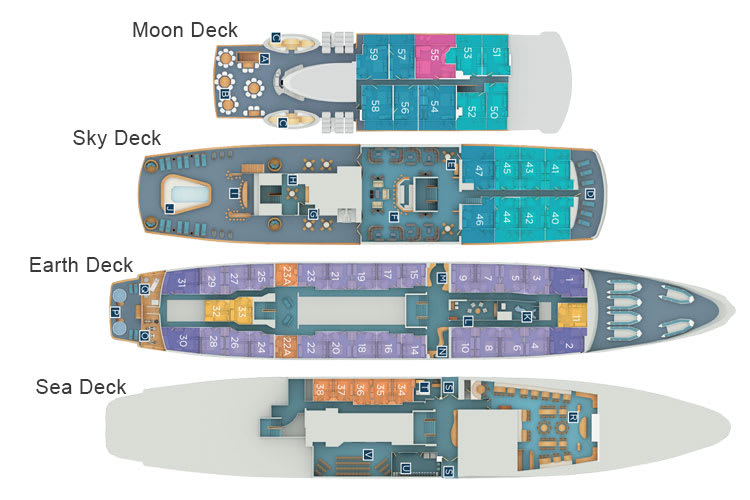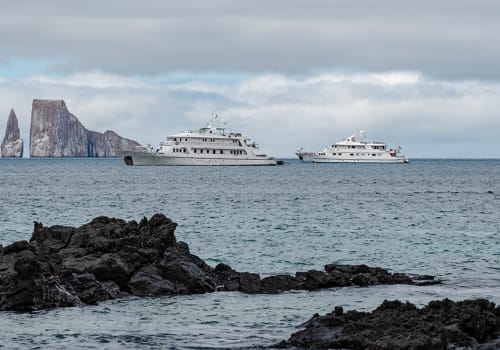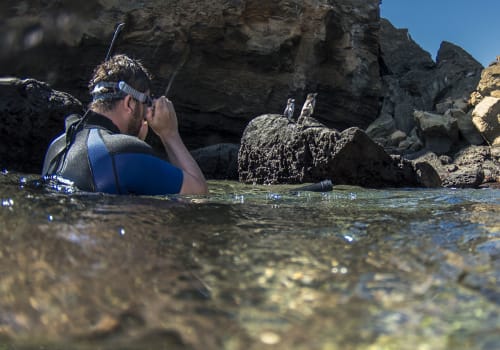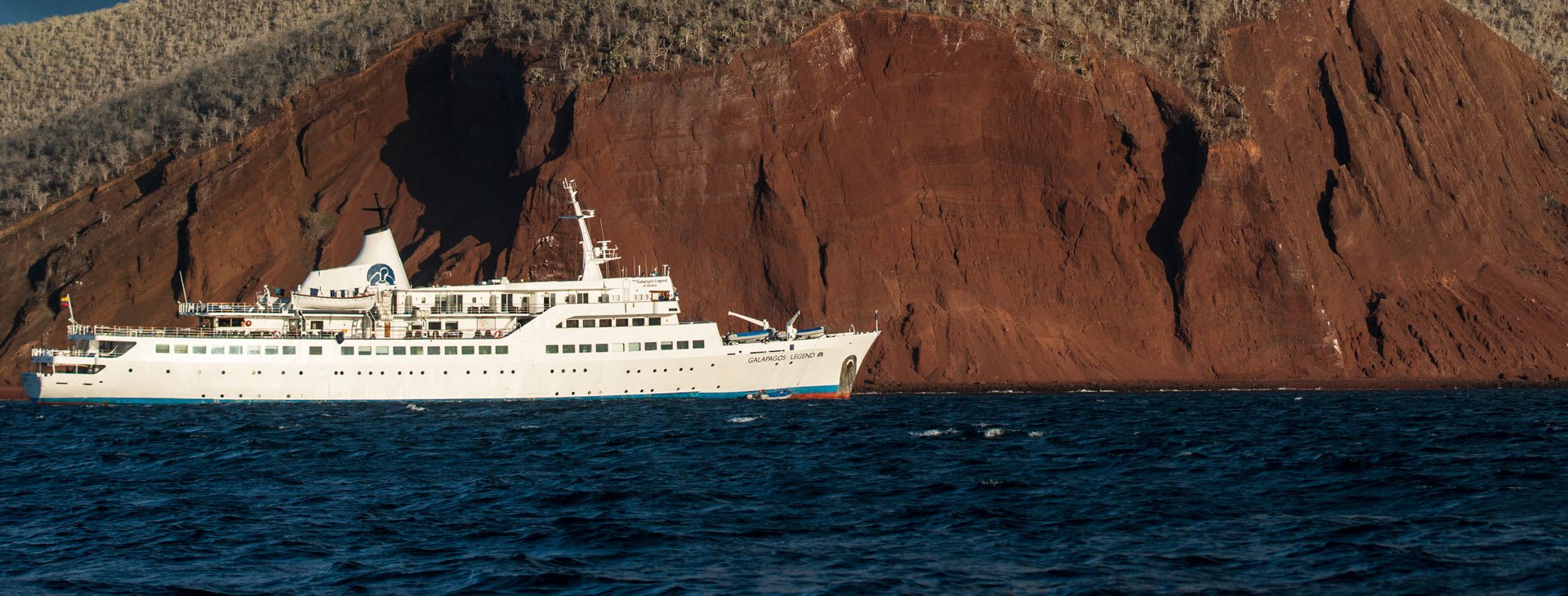
-
Family
-
Honeymoon
Overview
With 7,244 square feet of exterior space, the MV Galapagos Legend is a large vessel that offers amenities small boats can not match. Yet, the ship, which welcomes up to 100 guests, creates a warm, intimate experience fostered by cozy social areas, a laid-back attitude, and attentive service.
Life Aboard The Galapagos Legend Ship
The Galapagos Legend is the definition of casual cruising, and, between activities, you are free to roam the ship to explore all the exciting indoor and outdoor social areas. By day, lounge in the sun, take a dip in the pool, soak in one of the Jacuzzis on the sundeck, or work out in the fully-equipped fitness room or jogging track. Stop by the Fisherman’s Bar for a cocktail or a flute of chilled sparkling wine.
The fun continues late into the night with activities such as karaoke, salsa nights, movie nights, and a BBQ at the alfresco dining area. The Neptune Party, in which the ruler of the sea comes aboard the ship to reorganize his kingdoms, is not to be missed. Some itineraries even feature an Equatorial Line Party to celebrate crossing the equator, with guests receiving a certificate to commemorate the moment. If you prefer a bit of low-key after-dark fun, head to the moon deck for a stargazing presentation.
The ship’s highest spot soars 40 feet over the sea and offers a magnificent view of the islands. No matter what you do on or off the boat, keep your camera handy. As the cruise wraps up, there is a photo contest with the winners taking home fun prizes. You will need something delicious to eat to fuel all that fun, at the Lonesome George Restaurant has just the thing. Lunch is served as a buffet, and dinner includes à la carte options based on local and international specialties. Between meals, grab a bite at the 24-hour snack and coffee station.
Excursions From Your Galapagos Legend Cruise
The Galapagos Legend sails a total of eight itineraries, half of which are four-day trips. The other half are eight-day trips created by merging two of the shorter itineraries. Every day is a new opportunity for fun in the sun. Go ashore two times per day with a naturalist guide to see the most interesting spots on the Galapagos Islands.
Depending on your itinerary, you could take a dingy ride to a rarely visited Black Turtle Cove on Santa Cruz Island. The area has been declared a turtle sanctuary, and the creatures frequently peek out of the water to greet visitors. You may also stop at Egas Port on Santiago Island to hike along a black volcanic sand beach to see a colony of fur seals swimming in rocky pools.
There are also opportunities for snorkeling (and occasionally encountering a sea lion), paddling transparent kayaks while looking at the sea life swimming below you, and taking rides in a glass-bottom boat. For those looking to go a little deeper, you can opt-out of some planned activities in favor of scuba diving at an additional cost.
Fun For Little Cruisers
Do you have a budding adventurer or a fledgling explorer? A cruise aboard the Galapagos Legends ship is a treat for all ages, including your tiny tots. Not only will kids love the animal-focused activities on the schedule, but there is also a Kid’s Corner onboard the ship stocked with toys and games. Plus, cruising with kids could not be easier, thanks to interconnecting rooms with space for your whole crew. There are even special dates reserved as Family Cruises which include a children’s menu in the restaurant and kid-centric activities.
For a vacation that is just as thrilling on board as off, the MV Galapagos Legend is the place to be. And, with a wide range of cabins available, ranging from cozy interior rooms to the massive Legend Balcony Suite, you are sure to find a room to suit your style and budget.
Itineraries & Prices
All itineraries are subject to change due to seasonal weather conditions (and resultant variations in river and tributary water levels) affecting accessibility to locations. Thus navigation routes, times and excursions may need to be modified at the cruise captain’s or your guide's discretion.
Embarkation
AM: Passengers are picked up at the airport by our naturalist guides and taken on a ten-minute bus drive to the pier to board the M/V Galapagos Legend.
PM: In the mountains of the Galapagos it is possible to admire different kinds of birds, such as tree and ground finches, vermillion flycatchers, paint-billed crakes, yellow warblers, and cattle egrets (usually standing on the tortoises’ shell). The journey to the reserve offers great opportunities to see the contrasts that the island offers about a variety of ecosystems. The road goes from the coast through the agricultural zone and straight up to the dense humid forests. Often, Galapagos Giant Tortoises are also seen on the way, wandering through pastures in the paddocks. This spot is a bird watchers’ haven since almost every land bird present on the island lives or migrates here.
On the north shore of Santa Cruz Island at Black Turtle Cove, four species of mangrove crowd and form an internal lagoon. Turtles visit the calm waters, peaking their heads above the surface, while rays circle below. White-tipped reef sharks can be seen beneath the boat, plus sea birds, including pelicans, herons, and egrets. This cove has been declared as a “turtle sanctuary”.

El Barranco/Prince Philip's Steps & Darwin Bay
AM: Marvel at the variety of sea life that uses the crevices of the lava cliffs for shelter. Red-billed Tropicbirds fly overhead, switching between their nests and the bay, and a colony of fur seals may be found near the landing site. You will be dropped off at a steep stairway that begins on rocks at the foot of a path that leads through a seabird colony full of Nazca and Red-footed Boobies. At the plateau, the trail continues inland allowing you to see more nesting booby colonies in the thin Palo Santo forest. Near the end of the trail, over a rocky lava plain, wedge-rumped Storm-Petrels can be observed flying in all directions. If you are lucky, you may catch a glimpse of a Short-eared Owl.
PM: Disembark onto a small sand and coral beach. A short trail heads west along a tidal lagoon and then up a rocky hill that leads to a point overlooking the cliffs and Darwin Bay. Along the trail near the tidal lagoon, visitors will see pairs of Swallow-tailed Gulls, Lava Gulls, Yellow-crowned, and Lava Herons. The trail continues through Palo Santo trees, Opuntia cacti, and Saltbushes inhabited by Great Frigate birds and Red-footed Boobies. This is one of the few places in the islands where visitors are guaranteed to see Red-footed Boobies. It is estimated that more than 200,000 Red-footed Boobies live in the trees and bushes of Genovesa.
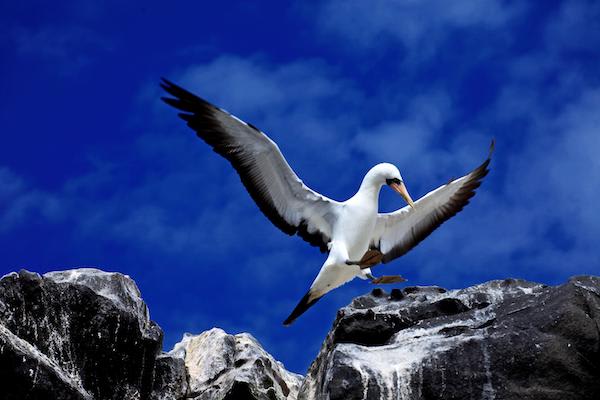
Dragon Hill & Santa Fe Island
AM: We walk by a brackish lagoon where feeding flamingoes can be found. The trail leads across typical dry zone vegetation up to Dragon Hill, an important nesting ground for endemic land iguanas, offering lovely views of the anchorage and neighboring islands. The forest is home to mockingbirds, Darwin’s finches, Yellow Warblers and Galapagos Doves.
PM: Santa Fe shows white sand beaches surrounded by sea lion colonies. Through the island path, an endemic cactus forest is passed, home to the Santa Fe land iguanas (the largest in the islands). This island is the habitat for several species, including the Galapagos hawk, Galapagos snakes, rice rats (one of the few endemic Galapagos rodents), a variety of finches, and one of the four mockingbird species of the archipelago.
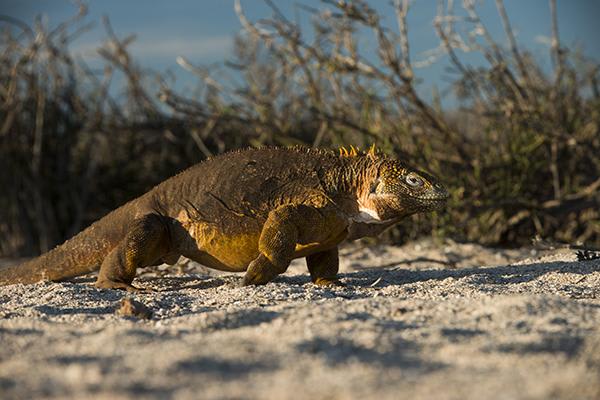
Disembarkation
AM: On the north side of Santa Cruz; behind the beach lies two small flamingo ponds where iguanas sunbathe, see coastal birds, Darwin finches, mockingbirds, and gulls, as well as interesting native vegetation like red and black mangrove, salt bushes. This beach is one of the main sea turtles' nesting sites in the Galapagos. A turtle can lay eggs 3 or 4 times per season with an average of 70 eggs each time. At this paradisiacal site, we will also find the remains of barges that sank a long time ago, when the United States Navy operated a base during World War II on Baltra Island. Local people modified the word barges to “Bachas”.
After the morning excursion, you will be assisted to Baltra airport for your flight to the mainland.
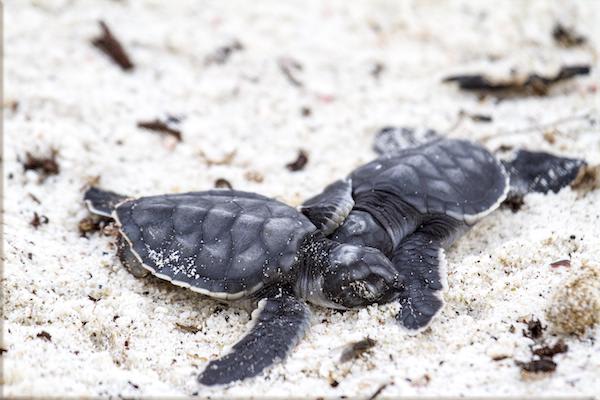
Embarkation
AM: Passengers are picked up at the airport by our naturalist guides and taken on a ten-minute bus drive to the pier to board the M/V Galapagos Legend.
PM: This flat, uplifted island, is an important spot to see both magnificent and great frigatebird males courting the females by clicking, bill-clapping, shuddering, and flapping their wings, all while showing off their grossly inflated, bright red, gular pouch. We will also likely see courting blue-footed boobies displaying their unique feet. Seal lions, swallow-tailed gulls, crashing surf, and distant views of the Daphne Islands top off a great visit.
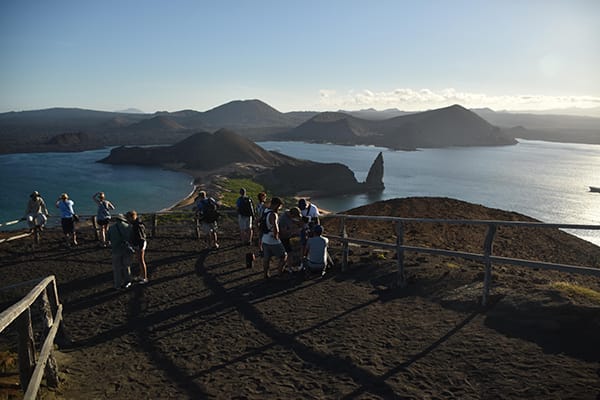
Bartolome Island & Sullivan Bay
AM: Considered the most iconic landscape of the entire archipelago the view from the top of Bartolome Island, overlooking the famous Pinnacle Rock and the austere Santiago Island beyond, is well worth the climb up the wooden boardwalk. This volcanic scene has often been likened to a lunar landscape. Our subsequent snorkel here might put us face to face with Galapagos Penguins, white-tipped reef sharks and playful sea lions.
PM: This site located at the southeastern portion of Santiago Island is of important geological interest. It features extensive relative young pa -hoe-hoe lava flows formed during the last quarter of the 19th century. In the middle of the lava flow, older-reddish-yellow-colored tuff cones appear. Mollugo plants with their yellow-to-orange whorled leaves usually grow out of the fissures. Walking on the solidified lava gives the impression of being in another planet. Tree molds are found, indicating that in that position large size plants grew in small crevices, until the lava flow of past eruptions burned down the flora of the island.
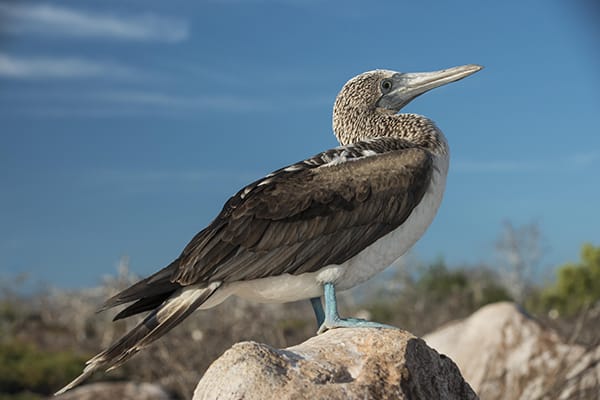
Pitt Point/Pitt Islet & Cerro Brujo
AM: Sea lions will greet us as we land on the beach and prepare for our climb to a high point on the steep eroded tuff cone. This is the only place in the islands where we will enjoy the chance to see all three of the booby species in the same place. The red foots will be perched on the Cordia lutea and small trees, the Nazcaís on the ground near the cliff edge while the blue-foots will be a little further inland. Frigatebirds will be all around and the views are breathtaking.
PM: From our pangas, as we head to shore, we are first humbled by the immensity of the stunning cliffs Cerro Brujo is an eroding tuff cone, that at several locations is composed of AA lava formations, and a beautiful white sand beach - perfect for snorkeling and sunbathing. We visit a lagoon where migratory bird species can be seen, including Black-necked Stilts, Ruddy Turnstones, Whimbrels, and White-cheeked Pintails. Cerro Brujo offers beautiful views of Kicker Rock, the southern part of San Cristobal, and the adjacent coast.
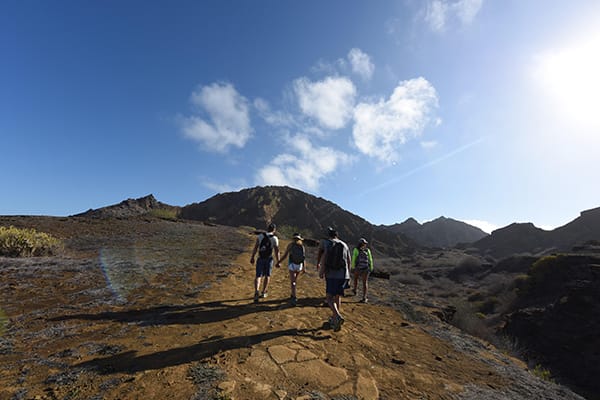
Disembarkation
AM: In the moist highlands of San Cristobal we will visit the giant tortoise breeding center La Glapaguera to witness the most iconic creature of the archipelago in its various life stages. The tortoises wander in a semi-natural habitat which lends itself to good threatened San Cristobal tortoise back into the wild. In town, there are shops to purchase local handicrafts and souvenirs.
After the visit, you will be assisted to San Cristobal airport for your flight to the mainland.
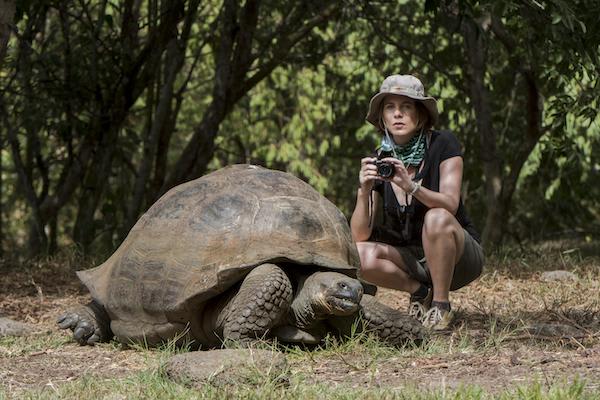
Embarkation
AM: Passengers are picked up at the Baltra airport by our naturalist guides and taken on a ten-minute bus drive to the pier to board the M/V Galapagos Legend.
PM: Mosquera Islet is located between North Seymour and Baltra Island. This flat, sandy island has a large colony of sea lions. It is also an excellent site to observe shorebirds such as herons and lava gulls. There is no trail on the islet, the visitor can enjoy the open area. Most of the islet is covered with sand and barren lava rock. Very little sesuvium portulacastrum plants grow on the sand.
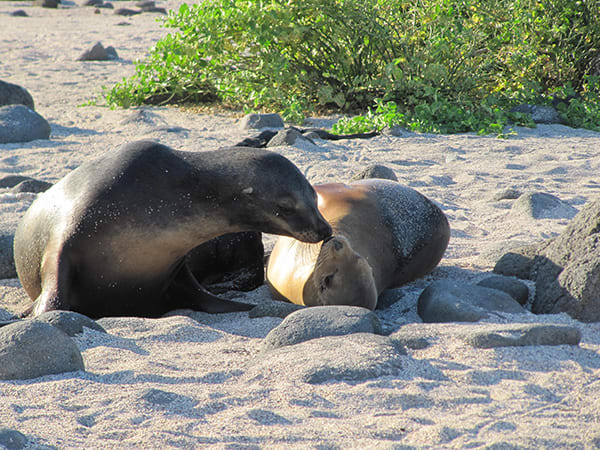
Egas Port & Rabida Island
AM: Egas Port is a black volcanic sand beach, visited by Darwin in 1835. The first section of the trail is formed of volcanic ash (eroded tuff) and the other half is an uneven terrain of volcanic basaltic rock. The unique, truly striking layered terrain of Santiago shore is home to a variety of animals. Find the bizarre yellow-crowned night heron and marine wildlife including lobster, starfish and marine iguanas grazing on algae beds alongside Sally light-foot crabs. It is easy to see colonies of endemic fur seals swimming in cool water volcanic rock pools.
PM: Dark-red sand covers these unique beaches with the incredible landscape; Rabida is considered the epicenter of the Galapagos Islands due to the diversity of its volcanic geology. Nesting Brown Pelicans are found from July through September and nine species of the famous Darwin’s finches can be seen. We will also take a dinghy ride along cliffs to observe nesting seabirds and snorkel off the coast, where marine life is particularly active.
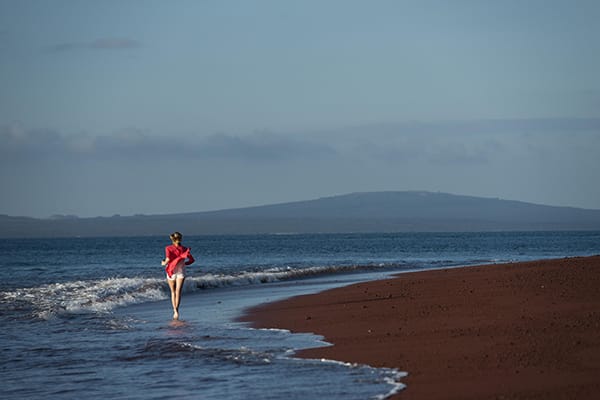
Urbina Bay & Tagus Cove
AM: Wet landing on a volcanic “black” beach. Depending on the season, we may find giant tortoises, land iguanas, and the unusual Flightless Cormorant. After a short walk inland, snorkeling time is allotted, giving you yet another chance to swim with sea turtles, sea lions, and countless tropical fish. Urbina Bay features a wide variety of plant life that changes depending on the season. We can observe the beautiful colors of plants that attract different insects, birds, and reptiles. We will explore the uplifted coral reef that resulted from the 1954 volcanic activity, with a spectacular view of Alcedo Volcano.
PM: Dry landing on the Galapagos’ largest island where we will learn about the eruption of the five volcanoes that form it. The trail leads to Darwin’s salt-water crater Lake and excellent views of lava fields and volcanic formations. We will return by the same path for a dinghy ride along the shoreline, where we will admire a variety of seabirds. Find species such as the Blue-footed Booby, Brown Noddy, terns, Flightless Cormorant and (depending on the season), a large number of Galapagos Penguins. The only penguin species in the world to extend their range into the northern hemisphere. They are monogamous and lay their eggs in small cracks of lava, on the lower parts of the island near the shoreline not reached by the ocean waves. The population of penguins on the islands is about 2,000 individuals, most of which live on this western portion of Isabela; others are situated further south on the island. We will have an opportunity to snorkel in deep water. Graffiti believed to have been left by 19th-century pirates is a curious reminder of an intriguing past.
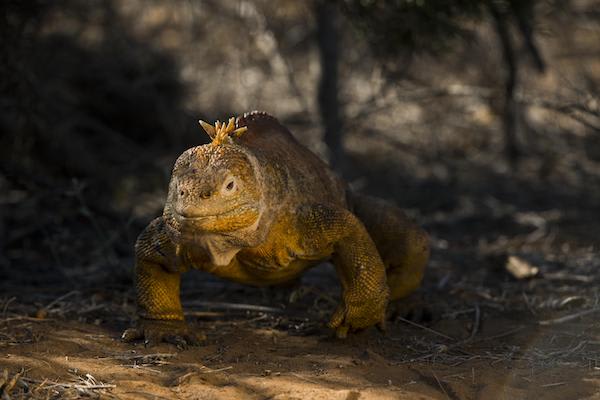
Espinosa Point & Vincente Roca Point
AM: Espinosa Point is the only spot that we visit on Fernandina, and from it, we can see the island of Isabela across the Bolívar Channel, an area that boasts some of the highest diversity of endemic sea fauna in the Galapagos. The largest, most primitive-looking race of marine iguanas are found mingling with sea lions and Sally Lightfoot Crabs; a wonderful opportunity to encounter Flightless Cormorants at their nesting sites, Galapagos Penguins, and the “King” of predators on the Islands, the Galapagos Hawk. “Pa-hoe-hoe” and “AA” lava formations cover the majority of the terrain. Vegetation is thus scarce inland, but we encounter Brachycereus cacti and extensive mangrove beds lining the shores.
PM: Great deep-water snorkeling at one of the richest marine havens on Earth (Bolívar Channel). We take a dinghy ride along the coast to observe a great diversity of sea and coastal birds. Find Nazca and blue-footed boobies, noddies, brown pelicans, penguins, and flightless cormorants. The upwelling of cold water currents in this part of the Galapagos gives rise to an abundance of marine life.
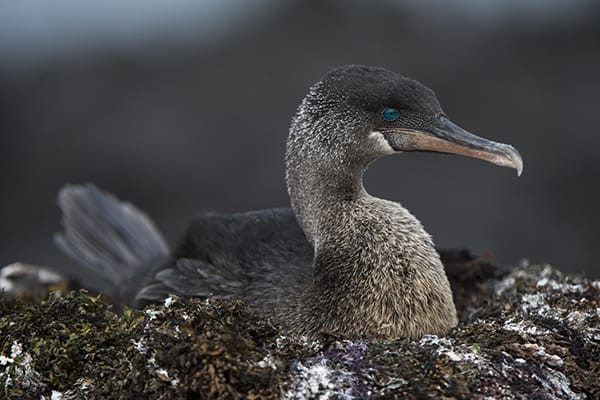
Disembarkation
AM: In the mountains of Galapagos is possible to admire different kinds of birds, such as tree and ground finches, vermillion flycatchers, paint-billed crakes, yellow warblers, and cattle egrets (usually standing on the tortoises’ shell). The journey to the reserve offers great opportunities to see the contrasts that the island offers in reference to the variety of ecosystems. The road goes from the coast through the agricultural zone and straight up to the dense humid forests. Often, Galapagos Giant Tortoises are also seen on the way, wandering through pastures in the paddocks. This spot is a birdwatchers’ haven since almost every land bird present on the island lives or migrates here.
After your visit, you will be transferred to Baltra airport for your return flight to Guayaquil or Quito.
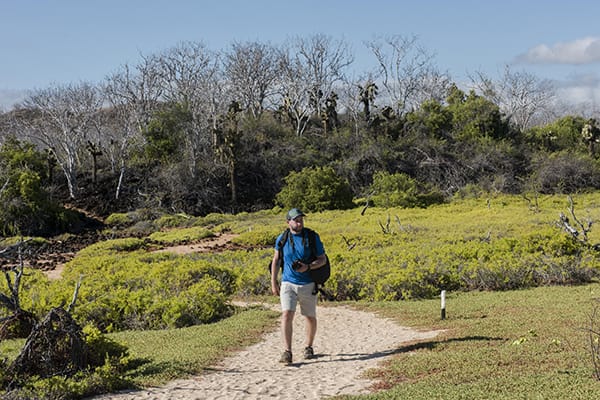
Embarkation
AM: Passengers are picked up at the airport by our naturalist guides and taken on a ten-minute bus drive to the pier to board the M/V Galapagos Legend.
PM: The interpretation center is full of interesting information and offers the perfect overview of the formation of the Galapagos, its significance in the world, threats, and conservation efforts. Followed by a hike to Frigatebird Hill (Cerro Tijeretas) we will have great looks at both species of frigatebird, with the bonus of a beautiful view of the bay below.
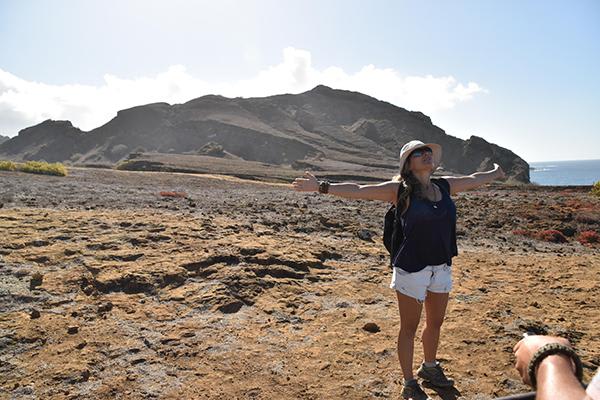
Gardner Bay & Suarez Point
AM: One of the most stunning beaches in all Galapagos. The long, white, sandy beach, lapped by turquoise waters is home to a colony of Galapagos sea lions, indifferent to the humans that walk amongst them. The Hood mockingbirds, endemic to this particular island, will be eager to inspect the visitors and satisfy their innate curiosity. Darwin's finches may also join the throng including the reclusive warbler finch. We can also snorkel here from the beach, in the shallows of the day.
PM: One of the highlights visit of the trip. Punta Suarez seems to have everything - a naturalist paradise. A slew of marine iguanas and sea lions greet us at the landing site from where our walk continues with close encounters with boobies, endemic lizards, gulls, and even dramatic blow hole. The oldest extant island in the archipelago is is our only opportunity to commune with the endemic wave albatross during their breeding season between April and December. With luck, we can watch their complex courtship display.
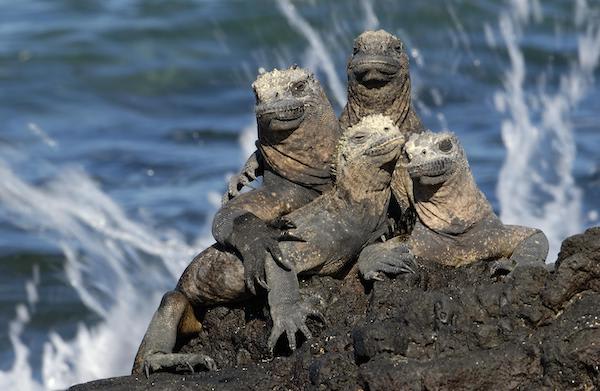
Post Office Bay, Cormorant Point, Devil's Crown & Champion Islet
AM: A very short walk from the beach lead us to the famous Post Office Barrel. Claimed to have been first set up in 1793 by Captain James Colnett it remains the oldest functioning post office in the Pacific. The system was that whalers and fur sealers would leave addressed letters in the barrel to be picked up by homeward bound colleagues. In the spirit of maintaining tradition visitors, today will often take letters and hand-deliver them to their home countries.
PM: Upon arrival to Cormorant Point, the observant visitor will notice that olivine, a volcanic crystal, has proffered a subtle green hue on the dark beach. Our walk takes us past island-endemic Scalesia plants to a large, shallow, lagoon often inhabited by a variable number of shockingly pink greater flamingoes. We continue through a forest of palo santo trees to arrive at a powdery white beach, a nesting area of green turtles. As we paddle barefoot in the shallow water we will spot diamond stingrays and white-tipped reef sharks.
Devil's Crown; one of the favorite snorkeling sites in the islands -an eroded volcanic cone, is home to an abundance of fish and marine animals. We will swim with big schools of yellow-tailed surgeonfish, salemas and creolefish and with luck may spot turtles, spotted eagle rays, parrotfish, and even hammerhead sharks! The jagged crown is a roosting area for boobies noddies, tropicbirds, and frigates.
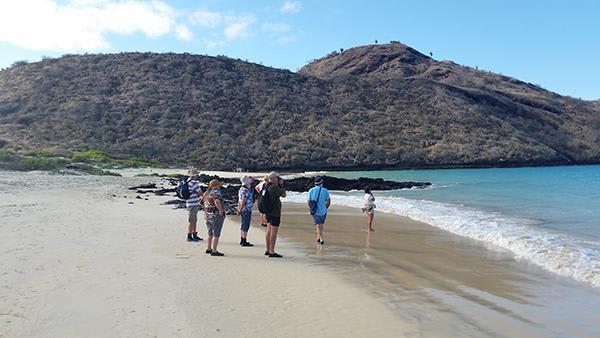
Dragon Hill & Punta Bowditch
AM: Arriving at small lava dock our first encounters are with marine iguanas that blend-in perfectly to the dark rock. As we walk past large prickly pear cacti we arrive at one end of a long sickle-shaped, beach with Dragon Hill standing in the distance. Our walk takes us on a circular path, past a shallow lake where flamingoes frequently come to feed. Waders such as stilts, turnstones, and sandpipers work the muddy edges frenetically looking for food as we continue inland to a dry forested habitat where land iguanas nest and burrow.
PM: Feel the indescribable feeling of being where no one else has. Relax on a powdery beach, snorkel around turquoise water islets and hike beside salt pools and dried white corals. Be one of the first -humans- to visit Punta Bowditch at Legend’s South itinerary D.
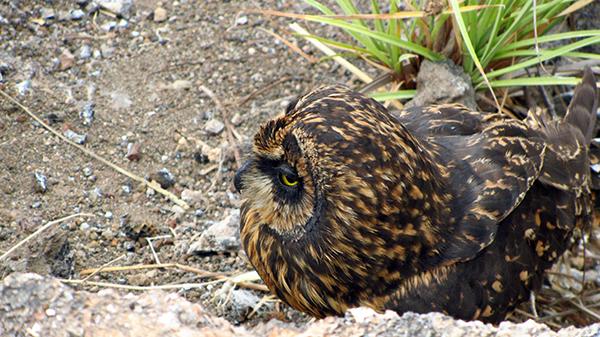
Disembarkation
AM: In the mountains of Galapagos is possible to admire different kinds of birds, such as tree and ground finches, vermillion flycatchers, paint-billed crakes, yellow warblers, and cattle egrets (usually standing on the tortoises’ shell). The journey to the reserve offers great opportunities to see the contrasts that the island offers in reference to the variety of ecosystems. The road goes from the coast through the agricultural zone and straight up to the dense humid forests. Often, Galapagos giant tortoises are also seen on the way, wandering through pastures in the paddocks. This spot is a "birdwatchers" haven, since almost every land bird present on the island livers or migrates here.
After the visit, you will be assisted to Baltra airport for your flight to the mainland.
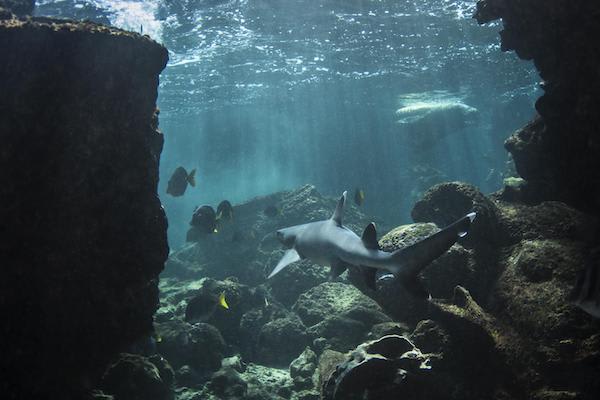
Embarkation
AM: Passengers are picked up at the airport by our naturalist guides and taken on a ten-minute bus drive to the pier to board the M/V Galapagos Legend.
PM: In the mountains of Galapagos is possible to admire different kinds of birds, such as tree and ground finches, vermillion flycatchers, paint-billed crakes, yellow warblers, and cattle egrets (usually standing on the tortoises’ shell). The journey to the reserve offers great opportunities to see the contrasts that the island offers about a variety of ecosystems. The road goes from the coast through the agricultural zone and straight up to the dense humid forests. Often, Galapagos Giant Tortoises are also seen on the way, wandering through pastures in the paddocks. This spot is a bird watchers’ haven since almost every land bird present on the island lives or migrates here.
On the north shore of Santa Cruz Island at Black Turtle Cove, four species of mangrove crowd and form an internal lagoon. Turtles visit the calm waters, peaking their heads above the surface, while rays circle below. White-tipped reef sharks can be seen beneath the boat, plus sea birds, including pelicans, herons, and egrets. This cove has been declared as a “turtle sanctuary”.
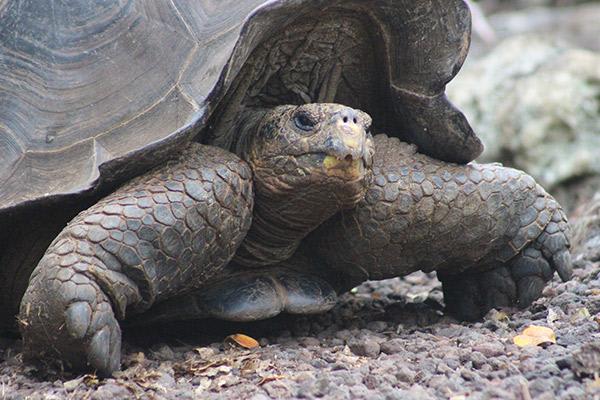
El Barranco/Prince Philip's Steps & Darwin Bay
AM: Marvel at the variety of sea life that uses the crevices of the lava cliffs for shelter. Red-billed Tropicbirds fly overhead, switching between their nests and the bay, and a colony of fur seals may be found near the landing site. You will be dropped off at a steep stairway that begins on rocks at the foot of a path that leads through a seabird colony full of Nazca and Red-footed Boobies. At the plateau, the trail continues inland allowing you to see more nesting booby colonies in the thin Palo Santo forest. Near the end of the trail, over a rocky lava plain, wedge-rumped Storm-Petrels can be observed flying in all directions. If you are lucky, you may catch a glimpse of a Short-eared Owl.
PM: Disembark onto a small sand and coral beach. A short trail heads west along a tidal lagoon and then up a rocky hill that leads to a point overlooking the cliffs and Darwin Bay. Along the trail near the tidal lagoon, visitors will see pairs of Swallow-tailed Gulls, Lava Gulls, Yellow-crowned, and Lava Herons. The trail continues through Palo Santo trees, Opuntia cacti, and Saltbushes inhabited by Great Frigate birds and Red-footed Boobies. This is one of the few places in the islands where visitors are guaranteed to see Red-footed Boobies. It is estimated that more than 200,000 Red-footed Boobies live in the trees and bushes of Genovesa.
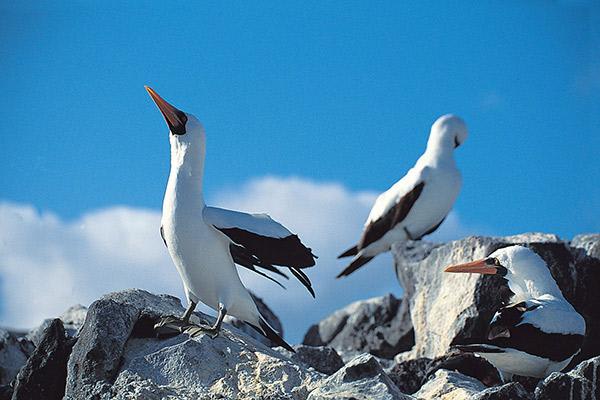
Dragon Hill & Santa Fe Island
AM: We walk by a brackish lagoon where feeding flamingoes can be found. The trail leads across typical dry zone vegetation up to Dragon Hill, an important nesting ground for endemic land iguanas, offering lovely views of the anchorage and neighboring islands. The forest is home to mockingbirds, Darwin’s finches, Yellow Warblers and Galapagos Doves.
PM: Santa Fe shows white sand beaches surrounded by sea lion colonies. Through the island path, an endemic cactus forest is passed, home to the Santa Fe land iguanas (the largest in the islands). This island is the habitat for several species, including the Galapagos hawk, Galapagos snakes, rice rats (one of the few endemic Galapagos rodents), a variety of finches, and one of the four mockingbird species of the archipelago.
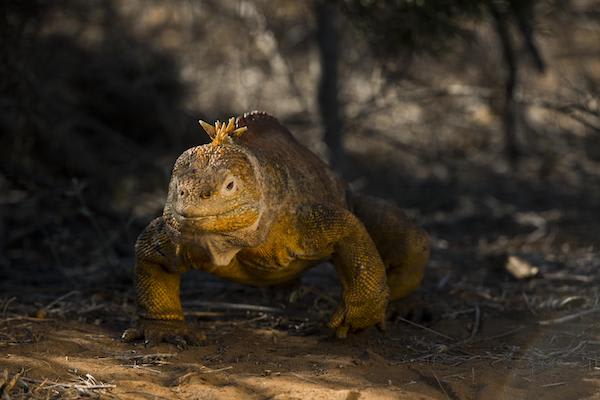
Bachas Beach & Mosquera Islet
AM: On the north side of Santa Cruz; behind the beach lies two small flamingo ponds where iguanas sunbathe, see coastal birds, Darwin finches, mockingbirds, and gulls, as well as interesting native vegetation like red and black mangrove, salt bushes. This beach is one of the main sea turtles' nesting sites in the Galapagos. A turtle can lay eggs 3 or 4 times per season with an average of 70 eggs each time. At this paradisiacal site, we will also find the remains of barges that sank a long time ago, when the United States Navy operated a base during World War II on Baltra Island. Local people modified the word barges to “Bachas”.
PM: Mosquera Islet is located between North Seymour and Baltra Island. This flat, sandy island has a large colony of sea lions. It is also an excellent site to observe shorebirds such as herons and lava gulls. There is no trail on the islet, the visitor can enjoy the open area. Most of the islet is covered with sand and barren lava rock. Very little sesuvium portulacastrum plants grow on the sand.
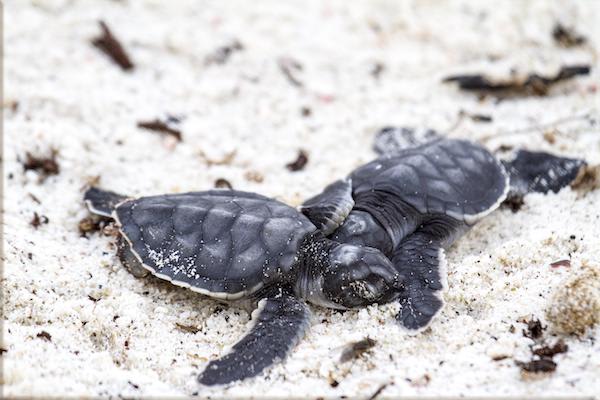
Egas Port & Rabida Island
AM: Egas Port is a black volcanic sand beach, visited by Darwin in 1835. The first section of the trail is formed of volcanic ash (eroded tuff) and the other half is an uneven terrain of volcanic basaltic rock. The unique, truly striking layered terrain of Santiago shore is home to a variety of animals. Find the bizarre yellow-crowned night heron and marine wildlife including lobster, starfish and marine iguanas grazing on algae beds alongside Sally light-foot crabs. It is easy to see colonies of endemic fur seals swimming in cool water volcanic rock pools.
PM: Dark-red sand covers these unique beaches with the incredible landscape; Rabida is considered the epicenter of the Galapagos Islands due to the diversity of its volcanic geology. Nesting Brown Pelicans are found from July through September and nine species of the famous Darwin’s finches can be seen. We will also take a dinghy ride along cliffs to observe nesting seabirds and snorkel off the coast, where marine life is particularly active.
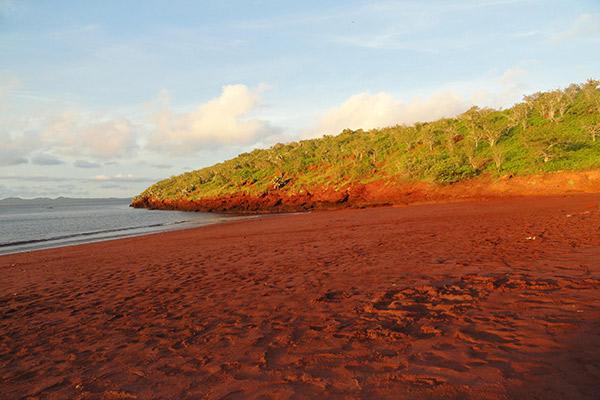
Urbina Bay & Tagus Cove
AM: Wet landing on a volcanic “black” beach. Depending on the season, we may find giant tortoises, land iguanas, and the unusual Flightless Cormorant. After a short walk inland, snorkeling time is allotted, giving you yet another chance to swim with sea turtles, sea lions, and countless tropical fish. Urbina Bay features a wide variety of plant life that changes depending on the season. We can observe the beautiful colors of plants that attract different insects, birds, and reptiles. We will explore the uplifted coral reef that resulted from the 1954 volcanic activity, with a spectacular view of Alcedo Volcano.
PM: Dry landing on the Galapagos’ largest island where we will learn about the eruption of the five volcanoes that form it. The trail leads to Darwin’s salt-water crater Lake and excellent views of lava fields and volcanic formations. We will return by the same path for a dinghy ride along the shoreline, where we will admire a variety of seabirds. Find species such as the Blue-footed Booby, Brown Noddy, terns, Flightless Cormorant and (depending on the season), a large number of Galapagos Penguins. The only penguin species in the world to extend their range into the northern hemisphere. They are monogamous and lay their eggs in small cracks of lava, on the lower parts of the island near the shoreline not reached by the ocean waves. The population of penguins on the islands is about 2,000 individuals, most of which live on this western portion of Isabela; others are situated further south on the island. We will have an opportunity to snorkel in deep water. Graffiti believed to have been left by 19th-century pirates is a curious reminder of an intriguing past.
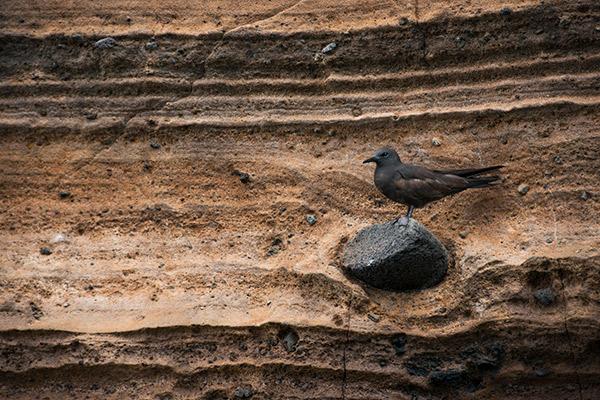
Espinosa Point & Vincente Roca Point
AM: Espinosa Point is the only spot that we visit on Fernandina, and from it, we can see the island of Isabela across the Bolívar Channel, an area that boasts some of the highest diversity of endemic sea fauna in the Galapagos. The largest, most primitive-looking race of marine iguanas* are found mingling with sea lions and Sally Lightfoot Crabs; a wonderful opportunity to encounter Flightless Cormorants at their nesting sites, Galapagos Penguins, and the “King” of predators on the Islands, the Galapagos Hawk. “Pa-hoe-hoe” and “AA” lava formations* cover the majority of the terrain. Vegetation is thus scarce inland, but we encounter Brachycereus cacti and extensive mangrove beds lining the shores.
PM: Great deep-water snorkeling at one of the richest marine havens on Earth (Bolívar Channel). We take a dinghy ride along the coast to observe a great diversity of sea and coastal birds. Find Nazca and blue-footed boobies, noddies, brown pelicans, penguins, and flightless cormorants. The upwelling of cold water currents in this part of the Galapagos gives rise to an abundance of marine life.
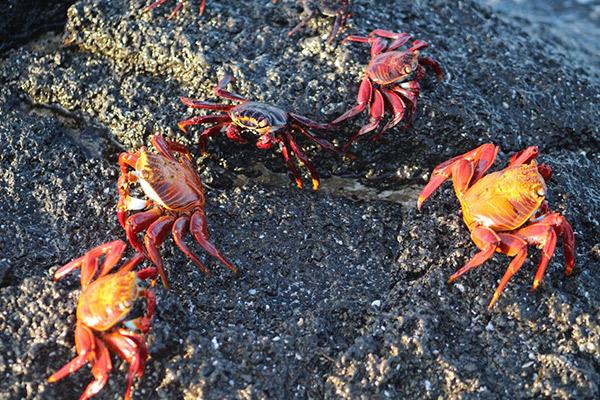
Disembarkation
AM: In the mountains of Galapagos is possible to admire different kinds of birds, such as tree and ground finches, vermillion flycatchers, paint-billed crakes, yellow warblers, and cattle egrets (usually standing on the tortoises’ shell). The journey to the reserve offers great opportunities to see the contrasts that the island offers in reference to the variety of ecosystems. The road goes from the coast through the agricultural zone and straight up to the dense humid forests. Often, Galapagos Giant Tortoises are also seen on the way, wandering through pastures in the paddocks. This spot is a birdwatchers’ haven since almost every land bird present on the island lives or migrates here.
After your visit, you will be transferred to Baltra airport for your return flight to Guayaquil or Quito.
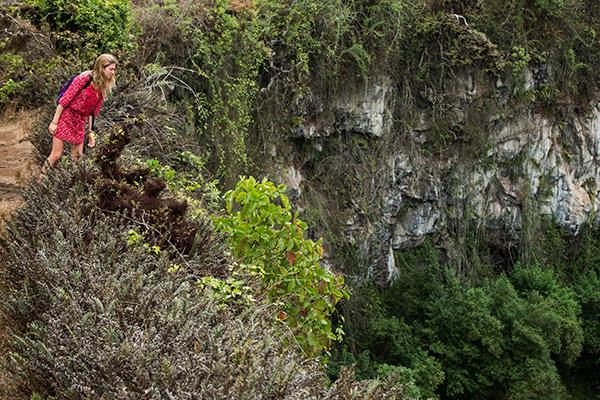
Embarkation
AM: Passengers are picked up at the Baltra airport by our naturalist guides and taken on a ten-minute bus drive to the pier to board the M/V Galapagos Legend.
PM: Mosquera Islet is located between North Seymour and Baltra Island. This flat, sandy island has a large colony of sea lions. It is also an excellent site to observe shorebirds such as herons and lava gulls. There is no trail on the islet, the visitor can enjoy the open area. Most of the islet is covered with sand and barren lava rock. Very little sesuvium portulacastrum plants grow on the sand.
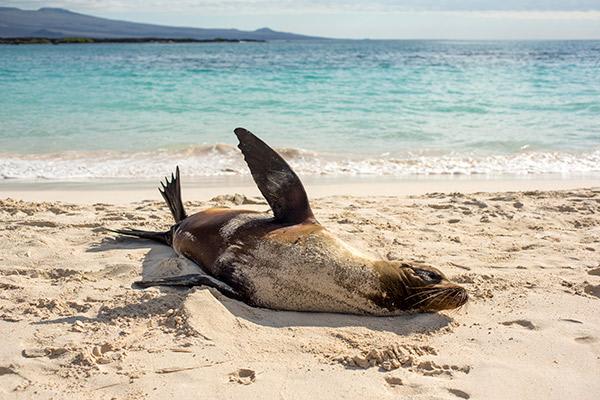
Egas Port & Rabida Island
AM: Egas Port is a black volcanic sand beach, visited by Darwin in 1835. The first section of the trail is formed of volcanic ash (eroded tuff) and the other half is an uneven terrain of volcanic basaltic rock. The unique, truly striking layered terrain of Santiago shore is home to a variety of animals. Find the bizarre yellow-crowned night heron and marine wildlife including lobster, starfish and marine iguanas grazing on algae beds alongside Sally light-foot crabs. It is easy to see colonies of endemic fur seals swimming in cool water volcanic rock pools.
PM: Dark-red sand covers these unique beaches with the incredible landscape; Rabida is considered the epicenter of the Galapagos Islands due to the diversity of its volcanic geology. Nesting Brown Pelicans are found from July through September and nine species of the famous Darwin’s finches can be seen. We will also take a dinghy ride along cliffs to observe nesting seabirds and snorkel off the coast, where marine life is particularly active.
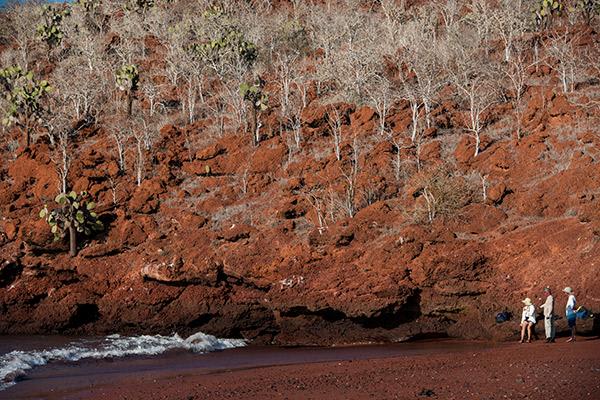
Urbina Bay & Tagus Cove
AM: Wet landing (might be difficult due to the tide). Volcanic black beach, depending on the season, it is possible to find giant tortoises, land iguanas, and the unusual flightless cormorant. After a short walk inland it´s snorkeling time, a chance to swim with sea turtles, sea lions, and countless tropical fish. Urbina Bay features a wide variety of plants with a different range of colors in flowers, attracting different insects, birds, and reptiles. One of the highlights of the island is the uplifted coral reef that resulted from the 1954 seismic activity; here the views of Alcedo Volcano are remarkable. When navigating from Urbina to Tagus Cove whale watching is usual in May – December.
PM: Dry landing on the Galapagos’ largest island where we will learn about the eruption of the five volcanoes that form it. The trail leads to Darwin’s salt-water crater Lake and excellent views of lava fields and volcanic formations. We will return by the same path for a dinghy ride along the shoreline, where we will admire a variety of seabirds. Find species such as the Blue-footed Booby, Brown Noddy, terns, Flightless Cormorant and (depending on the season), a large number of Galapagos Penguins. The only penguin species in the world to extend their range into the northern hemisphere. They are monogamous and lay their eggs in small cracks of lava, on the lower parts of the island near the shoreline not reached by the ocean waves. The population of penguins on the islands is about 2,000 individuals, most of which live on this western portion of Isabela; others are situated further south on the island. We will have an opportunity to snorkel in deep water. Graffiti believed to have been left by 19th-century pirates is a curious reminder of an intriguing past.

Espinosa Point & Vincente Roca Point
AM: Dry landing. From Espinosa Point, is possible to admire a wide view of Isabela Island across the Bolivar Channel, an area that boasts some of the highest diversity of endemic sea fauna in the Galapagos. Here the largest, most primitive-looking marine iguanas are found mingling with sea lions and Sally Lightfoot crabs. Fernandina displays a wonderful opportunity to encounter flightless cormorants at their nesting sites, Galapagos penguins and the “King” of predators on the islands, the Galapagos hawk. Pa-hoe-hoe and AA lava formations cover the majority of Fernandina terrain. Vegetation is scarce inland, with few brachycereus cacti. In the shore mangrove can be found.
PM: Great deep-water snorkeling at one of the richest marine havens on Earth, the Bolivar Channel. Accessible by water, we take a dinghy ride along the coast to observe a great diversity of sea and coastal birds; Nazca and blue-footed boobies, noddies, brown pelicans, penguins, flightless cormorants. The upwelling of cold water currents in this part of the Galapagos gives rise to an abundance of marine life, a perfect place for deep snorkeling.
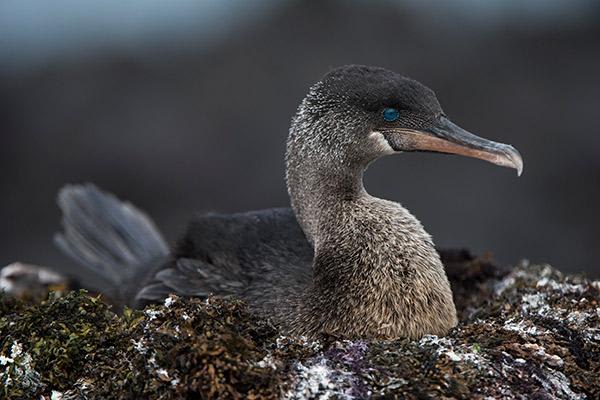
Highlands Tortoise Reserve & North Seymour
AM: In the mountains of Galapagos is possible to admire different kinds of birds, such as tree and ground finches, vermillion flycatchers, paint-billed crakes, yellow warblers, and cattle egrets (usually standing on the tortoises’ shell).
We visit the Station where the Galapagos giant tortoise breeding program takes places as part of our efforts to preserve the fragile Galapagos environment and where the famous Lonesome George (the last surviving specimen of his species) lived for decades.
PM: This flat, uplifted, island is an important spot to see both magnificent and great frigatebird males courting the females by clicking, bill-clapping, shuddering and flapping their wings, all while showing off their grossly inflated, bright red, gular pouch. We will also likely see courting blue-footed boobies displaying their unique feet while ëdancingí to a prospective mate. Sea lions, swallow-tailed gulls, crashing surf and distant views of the Daphne Islands top off a great visit.
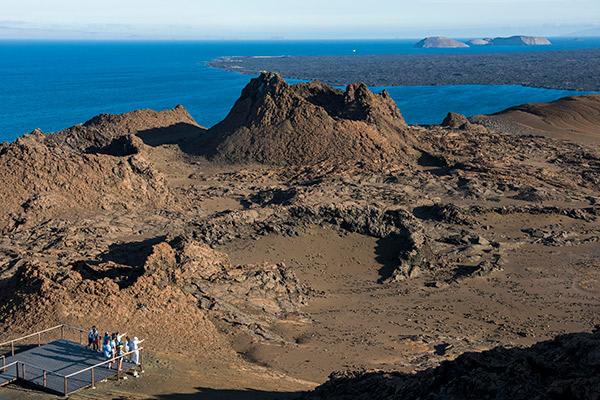
Bartolome Island & Sullivan Bay
AM: Considered the most iconic landscape of the entire archipelago the view from the top of Bartolomé Island, overlooking the famous Pinnacle Rock and the austere Santiago Island beyond, is well worth the climb up the wooden boardwalk. This volcanic scene has often been likened to a lunar landscape. Our subsequent snorkel here might put us face to face with Galapagos penguins, white-tipped reef sharks and playful sea lions.
PM: This site located at the southeastern portion of Santiago Island is of important geologic interest. It features extensive relative young pa-hoe-hoe lava flows formed during the last quarter of the 19th century. In the middle of the lava flow, older reddish-yellow-colored tuff cones appear. Mollugo plants with their yellow-to-orange whorled leaves usually grow out of the fissures. Walking on the solidified lava gives the impression of been in another planet. Tree molds are found, indicating that in that position large size plants grew in small crevices, until the lava flow of past eruptions burned down the flora of the island.
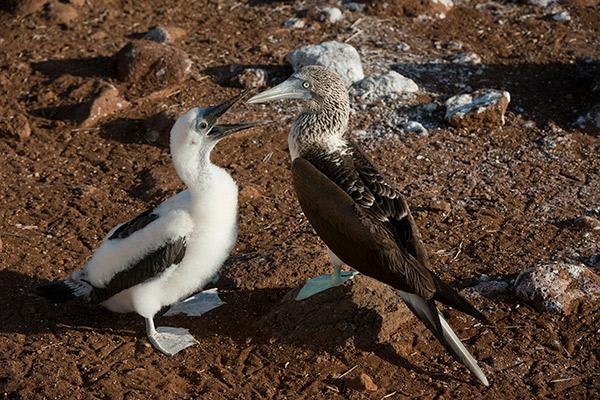
Pitt Point/Pitt Islet & Cerro Brujo
AM: Sea lions will greet us as we land on the beach and prepare for our climb to a high point on the steep eroded tuff cone. This is the only place in the islands where we will enjoy the chance to see all three of the booby species in the same place. The red-foots will be perched on the Cordia lutea and small trees, the Nazcaís on the ground near the cliff edge while the blue-foots will be a little further inland. Frigatebirds will be all around and the views are breathtaking.
PM: From our pangas, as we head to shore, we are first humbled by the immensity of the stunning cliffs of ëSorcererís Hillí. We can enjoy simply sharing the beach with sea lions, snorkeling from shore or take a walk to a hidden lagoon where we might spot black-necked stilts, ruddy turnstones, whimbrels and white-cheeked pintails.
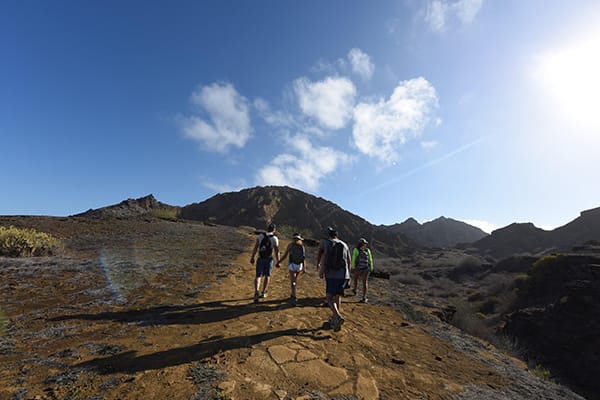
Disembarkation
AM: In the moist highlands of San Cristobal we will visit the giant tortoise breeding center La Galapaguera to witness the most iconic creature of the archipelago in its various life stages. The tortoises wander in a semi-natural habitat which lends itself to good photographic opportunities. The aim of the reserve is to help restore populations of the threatened San Cristobal tortoise back into the wild. In town, there are shops to purchase local handicrafts and souvenirs.ons of the threatened San Cristobal tortoise back into the wild. In town, there are shops to purchase local handicrafts and souvenirs.
After the visit, you will be assisted to San Cristobal airport for your flight to the mainland.
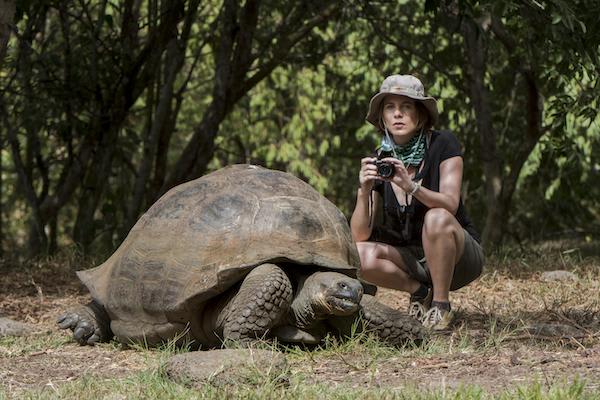
Embarkation
AM: Passengers are picked up at the airport by our naturalist guides and taken on a ten-minute bus drive to the pier to board the M/V Galapagos Legend.
PM: Dry landing. Off Baltra Island and not far from Santa Cruz, North Seymour is located. This landmass was formed by a series of underwater volcanic eruptions, which deposited layers of lava on the ocean floor. An approximately two-hour walk amidst large nesting colonies of blue-footed boobies, magnificent and great frigate birds, and swallow-tailed gulls for an in-depth encounter with sea bird breeding cycles and sea lions. You will also encounter land iguanas, and on a lucky day, you might even come across the endemic Galapagos Snake.
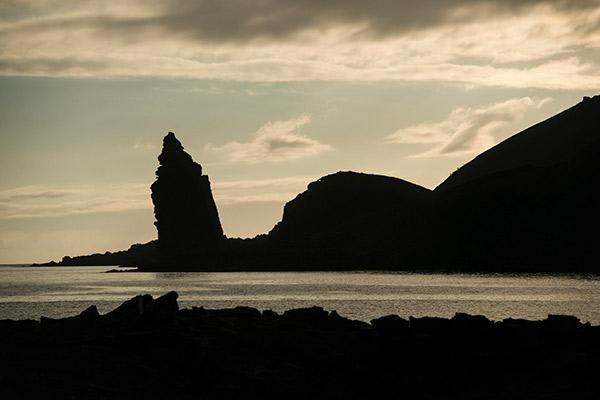
Pinnacle Rock & Sullivan Bay
AM: Dry or wet landing. We discover a fascinating landscape formed by different volcanic parasitic cones —lava bombs, spatter, cinder cones — that resembles the moon. Going up to the summit there will be an impressive view of the surrounding islands, including the eroded tuff cone Pinnacle Rock. We also encounter marine iguanas, lava lizards, and blue-footed boobies.
Beach time is a great opportunity to do snorkeling and see the famous Galapagos Penguins, sea turtles and White-tipped Reef Sharks among a great variety of colorful fish. For many visitors, this may turn out to be the best snorkeling experience. Crystal clear water is the perfect spot to appreciate the incredible marine life it has to offer.
Due to its geographical location, the lack of vegetation is immediately noticeable however, there are pioneer plants including the endemic Tiquilia nesiotica and Chamaesyce (known as sand mat or spurge in English), lava cactus, and Scalesia bushes.
PM: Wet landing. This site located at the southeastern portion of Santiago Island is of important geological interest. It features extensive relative young pa -hoe-hoe lava flows formed during the last quarter of the 19th century. In the middle of the lava flow, older-reddish-yellow-colored tuff cones appear. Mollugo plants with their yellow-to-orange whorled leaves usually grow out of the fissures. Walking on the solidified lava gives the impression of being in another planet. Tree molds are found, indicating that in that position large size plants grew in small crevices, until the lava flow of past eruptions burned down the flora of the island.
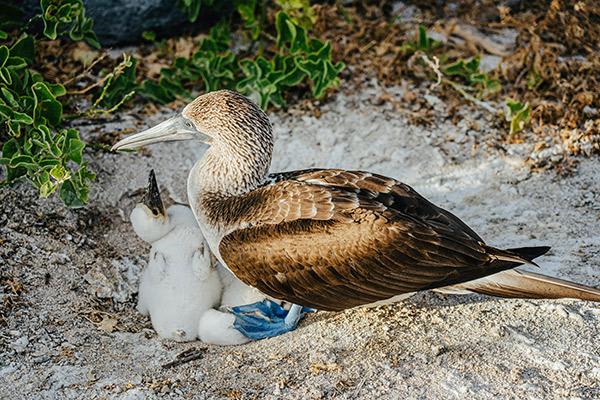
Pitt Point/Pitt Islet & Cerro Brujo
AM: Wet landing followed by a high-intensity hike on rocky terrain. The trail includes a 90 meters long, olivine beach and a path that climbs to the top of a volcanic tuff, through several magnifi ent viewpoints. This is probably the only site where the three booby species of the Galapagos can be seen together, as well as, two species of frigate birds and a sea lion colony. It is also excellent for dinghy rides and snorkeling, where a good range of sea birds can be observed.
PM: Cerro Brujo is an eroding tuff cone, that at several locations is composed of AA lava formations, and a beautiful white sand beach - perfect for snorkeling and sunbathing. We visit a lagoon where migratory bird species can be seen, including Black-necked Stilts, Ruddy Turnstones, Whimbrels, and White-cheeked Pintails. Cerro Brujo offers beautiful views of Kicker Rock, the southern part of San Cristobal, and the adjacent coast.
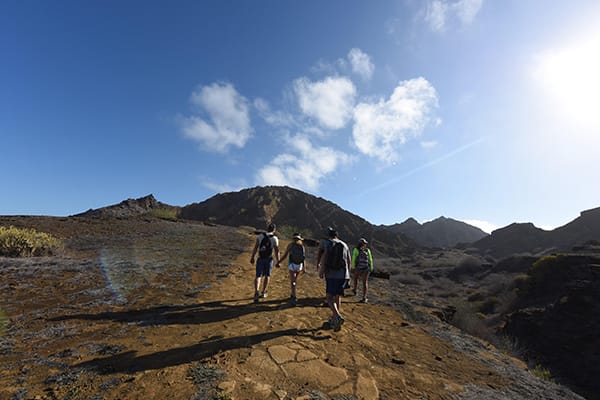
Tortoise Reserve & Interpretation Center
AM: Dry landing in Puerto Baquerizo Moreno; visit the San Cristobal Giant Tortoise Breeding Center to learn about the National Park’s conservation programs. Enjoy a beautiful landscape on the way to the Reserve. Passengers will also have the opportunity to visit the village’s port, have a drink or shop for arts and crafts and other souvenirs.
PM: Visit the Interpretation Center, an excellent place to learn about islands’ history in The Museum of Natural History which displays information about the volcanic origins of the islands, their remoteness from the continent, ocean currents, climate, the arrival of the different species and their colonization, among other points of interest. The human history is also showcased, chronologically narrating the most significa t events related to the discovery and the island’s colonization.
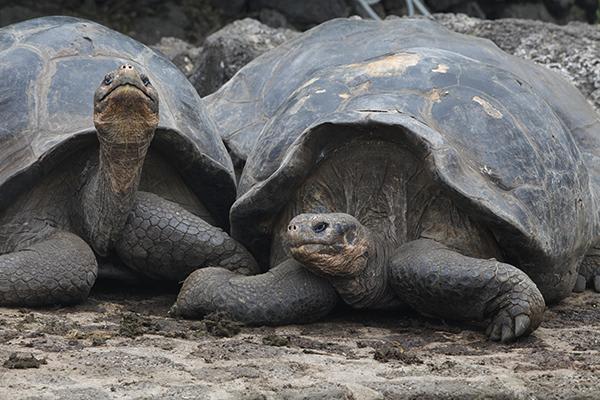
Gardner Bay, Osborn Islet & Suarez Point
AM: One of the most stunning beaches in all Galapagos. The long, white, sandy beach, lapped by turquoise waters is home to a colony of Galapagos sea lions, indifferent to the humans that walk amongst them. The Hood mockingbirds, endemic to this particular island, will be eager to inspect the visitors and satisfy their innate curiosity. Darwin's finches may also join the throng including the reclusive warbler finch. We can also snorkel here from the beach, in the shallows of the day.
PM: Dry landing. An island of geological interest, we explore volcanic formations and a riveting wildlife: large sea lion colonies and seabirds including the Española mockingbird, Nazca Boobies, and the spectacular Red-billed Tropicbird. You will also encounter marine iguanas, lava lizards, and the colorful Sally Lightfoot Crabs.
A somewhat lengthy hike will bring you among Nazca and Blue-footed Boobies, right up to nesting grounds that sometimes overlap the trail. Other birding favorites include Galapagos Dove, Galapagos Hawk, Swallow-tailed Gulls and the world’s largest colony of Waved Albatross, an unequivocal highlight during mating season (May-December). Admire the island’s dramatic backdrop, featuring the famous “Soplador”, a seaward blowhole that shoots up water up to 23 m (75 ft) in the air.
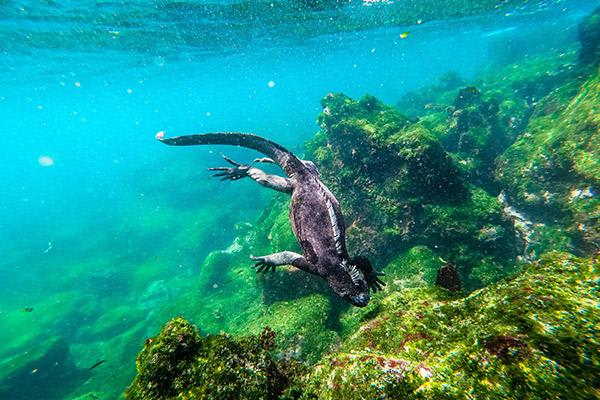
Post Office Bay, Cormorant Point, Devil's Crown & Champion Islet
AM: Wet landing. Located on the north side of Floreana, the bay was named because in 1793 Captain James Colnett installed a wooden barrel that served as an informal post office for sailors passing through, who would take letters with them back to their destinations. Today, visitors continue the tradition by placing unstamped postcards inside the barrel, hoping that some other traveler, going to the letter destination, will take it back for free. The chances are that the letter posted can take a long time to arrive at its destination. However, there have been cases where it has arrived before the sender.
We may also encounter Darwin’s finches, Yellow Warbler and Lava Lizards. Great snorkeling opportunities with Green Pacific Sea Turtles. As well, the island is best known for its endemic vegetation: Scalesia villosa, Lecocarpus Pinnatifidus, and the Galapagos Milkwort. Snorkelers can practice on the main beach among playful sea lions.
PM: Wet landing, on an olivine green, sanded beach. We hike from the black mangrove beds to a brackish lagoon, which usually holds one of the largest flamingo popul tions in the Galapagos. This island features some endemic plants such as Scalesia villosa, white and black mangrove, and holy stick. The trail continues to a beautiful white sandy beach, one of the most important nesting sites of Green Pacific Sea Turtles. It is important to avoid walking in the water due to the Sting Rays that may be hiding in the sand, which can be dangerous if accidentally stepped on. From the beach, one can spot sea turtles, blue-footed boobies plunging into the water, and small reef sharks flo ting along the shoreline in the search for food.
This coral-sand beach marks the end of our trail, and we head back to the olivine beach we landed on, to swim or snorkel amongst sea turtles, reef fish, sea lions and, on a good d y, white-tipped reef sharks. A small colony of penguins resides on Floreana and can sometimes be observed as well.
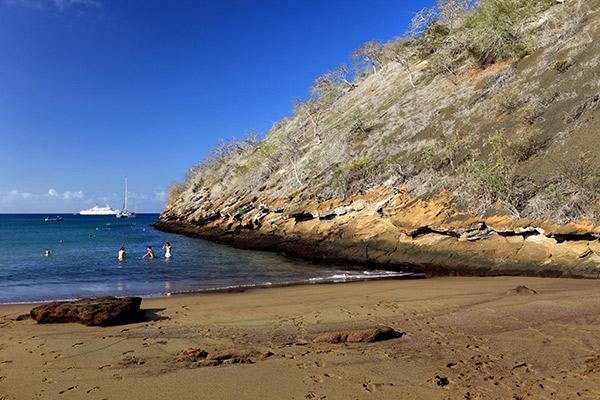
Dragon Hill & Punta Bowditch
AM: Arriving to a small lava dock our first entocunters are with marine iguanas that blend-in perfectly to the dark rock. As we walk past large prickly pear cacti we arrive to one end of a long, sickle-shaped, beach with Dragon Hill standing in the distance. Our walk takes us on a circular path, pastshallow lake where flamingoes frequently come to feed. Waders such us as stilts, turnstones and sandipipers work the muddy edges frenetically looking for food as we continue inland to a dry, forested habitat where land iguanas nest and burrow.
PM: Feel the indescribable feeling of being where no one else has. Relax on a powdery beach, snorkel around turquoise water islets and hike beside salt pools and dried white corals. Be one of the first -humans- to visit Punta Bowditch at Legend’s South itinerary D.
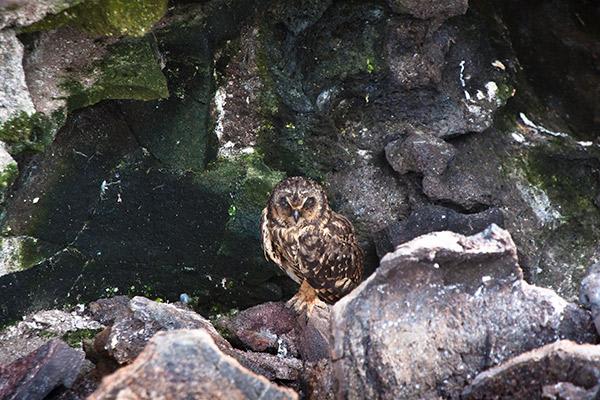
Disembarkation
AM: Dry landing. In the mountains of Galapagos is possible to admire different kind of birds, such as: tree and ground finches, vermillion flycatchers, paint-billed crakes, yellow warblers, and cattle egrets (usually standing on the tortoises' shell). The journey to the reserve offers great opportunities to see the contrasts that the island offers in reference to the variety of ecosystems. The road goes from the coast through the agricultural zone and straight up to the dense humid forests. Often, Galapagos Giant Tortoises are also seen on the way, wandering through pastures in the paddocks. This spot is a birdwatchers’ haven, since almost every land bird present on the island lives or migrates here.
After the visit, you will be assisted to Baltra airport for your flight to the mainland.
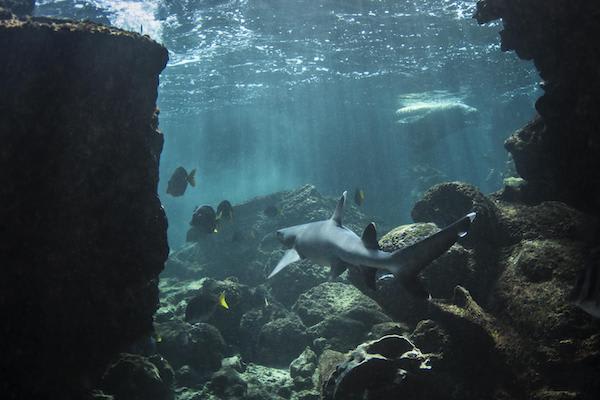
Embarkation
AM: Passengers are picked up at the airport by our naturalist guides and taken on a ten-minute bus drive to the pier to board the M/V Galapagos Legend.
PM: Dry landing in Puerto Baquerizo Moreno, capital of the Galapagos Islands. Passengers visit the Interpretation Center, an excellent place to learn about Natural History in the Galapagos. The Museum of Natural History displays information on the volcanic origins of the islands, their remoteness from the continent, ocean currents, climate, and the arrival of different species. Human history is also showcased, narrating the most significant events related to the discovery and colonization of the islands.
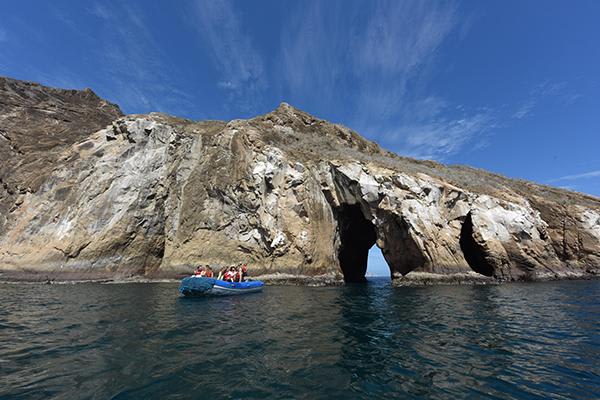
Gardner Bay, Osborn Islet & Suarez Point
AM: We start this morning with a wet landing on a beautiful white coral sand beach guarded by a colony of sea lions. There are no trails, so we stay along the shore where we can spot Galapagos hawks, American Oystercatchers, Galapagos Ground Doves, Hood mockingbirds, Yellow Warblers, lava lizards, marine iguanas, and three species of Darwin’s finches: a subspecies (Geospiza fuliginosa) of the Large Cactus Finch, which is similar to the large ground finch, the Small Ground Finch (Geospiza fuliginosa) and the Warbler Finch (Certhidea Olivacea), another endemic subspecies. Swimming and snorkeling offer a great variety of Galapagos marine wildlife: king angelfish, Creole fish, damselfish, parrotfish, manta rays, and white-tipped reef sharks.
PM: An island of geological interest, we explore volcanic formations and riveting wildlife: large sea lion colonies and seabirds including Española mockingbird, Nazca Boobies, and the spectacular Red-billed Tropicbird. You will also encounter marine iguanas, lava lizards, and the colorful Sally Lightfoot Crabs. A somewhat lengthy hike will bring you among Nazca and Blue-footed Boobies, right up to nesting grounds that sometimes overlap the trail. Other birding favorites include Galapagos Dove, Galapagos Hawk, Swallow-tailed Gulls, and the world’s largest colony of Waved Albatross, an unequivocal highlight during mating season (May-December). Admire the island’s dramatic backdrop, featuring the famous Soplador, a seaward blowhole that shoots water some 23 m. (75 ft.) in the air.
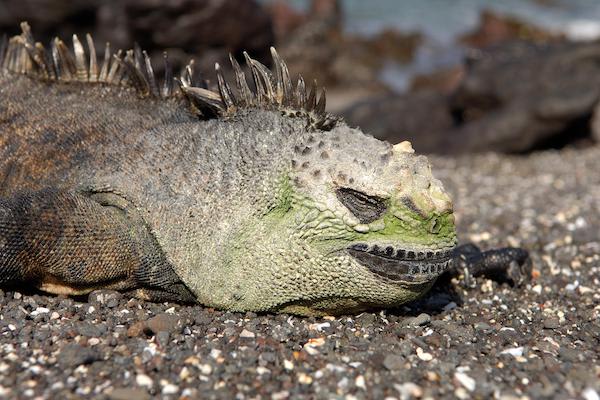
Post Office Bay, Cormorant Point, Devil's Crown & Champion Islet
AM: Wet landing. Located on the north side of Floreana, the bay was named because in 1793 Captain James Colnett installed a wooden barrel that served as an informal post office for sailors passing through, who would take letters with them back to their destinations. Today, visitors continue the tradition by placing unstamped postcards inside the barrel, hoping that some other traveler, going to the letter destination, will take it back for free. The chances are that the letter posted can take a long time to arrive at its destination. However, there have been cases where it has arrived before the sender.
We may also encounter Darwin’s finches, Yellow Warbler and Lava Lizards. Great snorkeling opportunities with Green Pacific Sea Turtles. As well, the island is best known for its endemic vegetation: Scalesia villosa, Lecocarpus Pinnatifidus, and the Galapagos Milkwort. Snorkelers can practice on the main beach among playful sea lions.
PM: Wet landing, on an olivine green, sanded beach. We hike from the black mangrove beds to a brackish lagoon, which usually holds one of the largest flamingo popul tions in the Galapagos. This island features some endemic plants such as Scalesia villosa, white and black mangrove, and holy stick. The trail continues to a beautiful white sandy beach, one of the most important nesting sites of Green Pacific Sea Turtles. It is important to avoid walking in the water due to the Sting Rays that may be hiding in the sand, which can be dangerous if accidentally stepped on. From the beach, one can spot sea turtles, blue-footed boobies plunging into the water, and small reef sharks flo ting along the shoreline in the search for food.
This coral-sand beach marks the end of our trail, and we head back to the olivine beach we landed on, to swim or snorkel amongst sea turtles, reef fish, sea lions and, on a good d y, white-tipped reef sharks. A small colony of penguins resides on Floreana and can sometimes be observed as well.

Dragon Hill & Punta Bowditch
AM: Arriving to a small lava dock our first entocunters are with marine iguanas that blend-in perfectly to the dark rock. As we walk past large prickly pear cacti we arrive to one end of a long, sickle-shaped, beach with Dragon Hill standing in the distance. Our walk takes us on a circular path, pastshallow lake where flamingoes frequently come to feed. Waders such us as stilts, turnstones and sandipipers work the muddy edges frenetically looking for food as we continue inland to a dry, forested habitat where land iguanas nest and burrow.
PM: Feel the indescribable feeling of being where no one else has. Relax on a powdery beach, snorkel around turquoise water islets and hike beside salt pools and dried white corals. Be one of the first -humans- to visit Punta Bowditch at Legend’s South itinerary D.
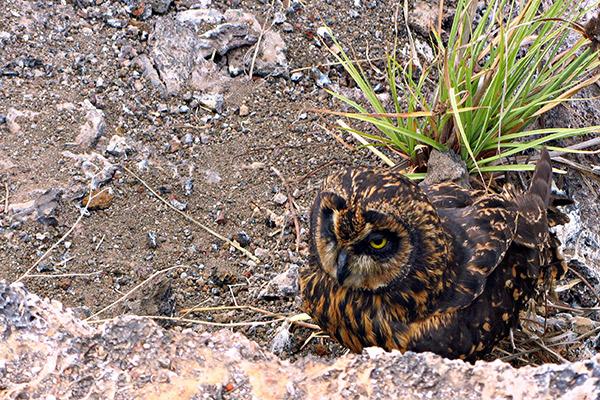
Darwin Station, Highlands Tortoise Reserve & Black Turtle Cove
AM: We visit the Station where the Galapagos giant tortoise breeding program takes famous Lonesome George (the last surviving specimen of his species) lived for decades. Darwin Station also works providing environmental education to the communities, schools, and tourists visiting the Galapagos Islands. You will also have some free time to visit the town and shop for souvenirs.
In the mountains of the Galapagos it is possible to admire different kinds of birds, such as tree and ground finches, vermillion flycatchers, paint-billed crakes, yellow warblers, and cattle egrets (usually standing on the tortoises’ shell). The journey to the reserve offers great opportunities to see the contrasts that the island offers about a variety of ecosystems. The road goes from the coast through the agricultural zone and straight up to the dense humid forests. Often, Galapagos Giant Tortoises are also seen on the way, wandering through pastures in the paddocks. This spot is a bird watchers’ haven since almost every land bird present on the island lives or migrates here.
PM: On the north shore of Santa Cruz Island at Black Turtle Cove, four species of mangrove crowd and form an internal lagoon. Turtles visit the calm waters, peaking their heads above the surface, while rays circle below. White-tipped reef sharks can be seen beneath the boat, plus sea birds, including pelicans, herons, and egrets. This cove has been declared as a “turtle sanctuary”.

El Barranco/Prince Philip's Steps & Darwin Bay
AM: Be marvelled at the variety of sea life that uses the crevices of the lava cliffs or shelter. Red-billed Tropicbirds fly overhead, switching between their nests and the bay, and a small colony of fur seals may be found near the landing site. You will be dropped off at a steep
stairway that begins on rocks at the foot of a path that leads through a seabird colony full of Nazca and Red-footed Boobies. At the plateau, the trail continues inland allowing you to see more nesting booby colonies in the thin Palo Santo forest. Near the end of the trail, over a rocky lava plain, Wedge-rumped Storm-Petrels can be observed flying in all directions. If you are lucky, you may catch a glimpse of a Short-eared Owl.
PM: Disembark onto a small sand and coral beach. A short trail heads west along a tidal lagoon and then up a rocky hill that leads to a point overlooking the cliffs and Darwin Bay. Along the trail near the tidal lagoon, visitors will see pairs of Swallow-tailed Gulls, Lava Gulls, Yellow-crowned, and Lava Herons. The trail continues through Palo Santo trees, Opuntia cacti, and Saltbushes inhabited by Great Frigate birds and Red-footed Boobies. This is one of the few places in the islands where visitors are guaranteed to see Red-footed Boobies. It is estimated that more than 200,000 Red-footed Boobies live in the trees and bushes of Genovesa.
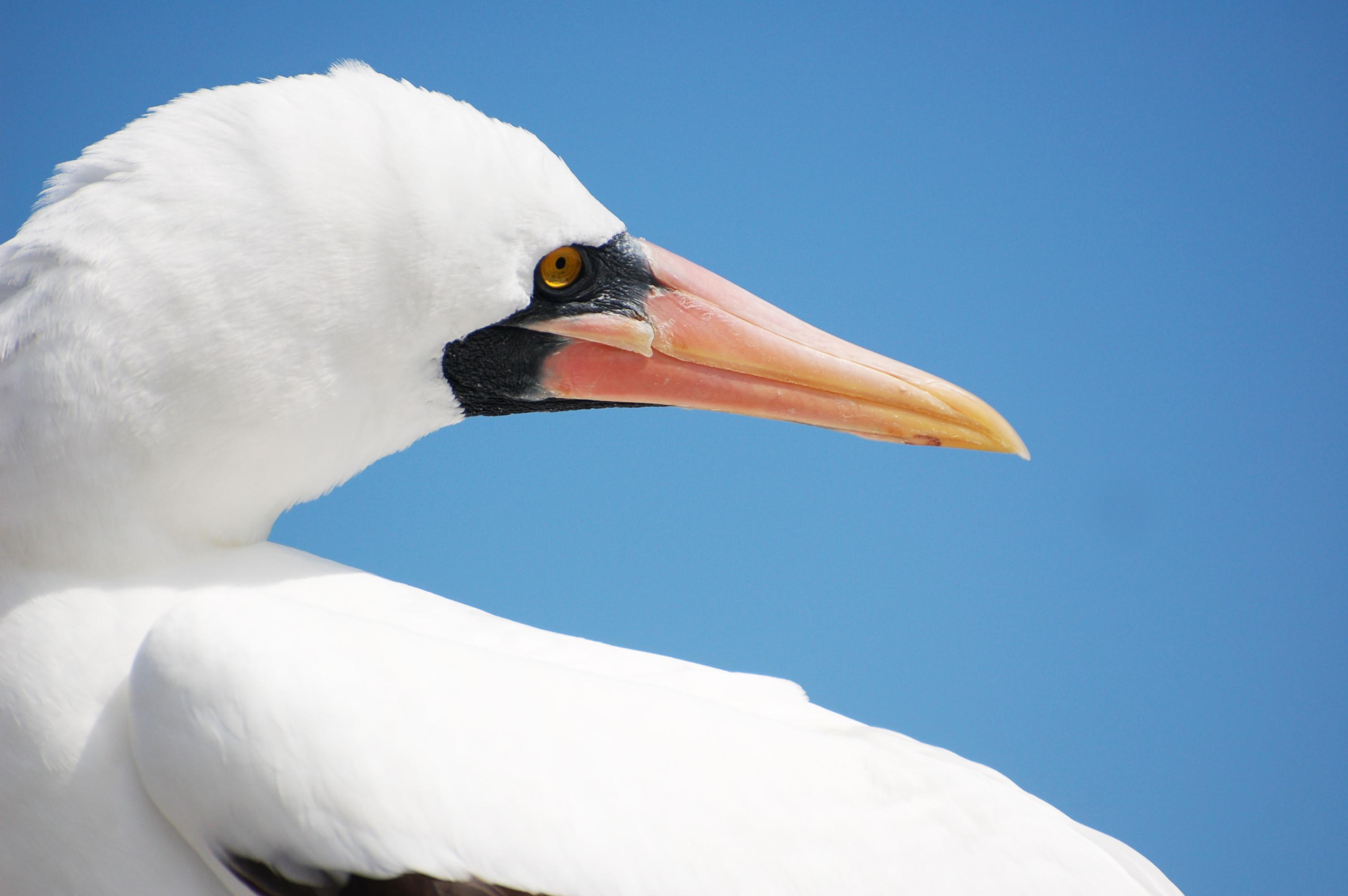
South Plaza & Santa Fe Island
AM: Sea lions, swallow-tailed gulls and land iguanas are all present at the landing site. The small island is covered with a carpet of a red succulent studded with Opuntia cacti. At the cliff edge, we spend time watching birds fly past at eye level in the updraught. These include frigatebirds, flocks of Galapagos shearwaters and of particular note, flights of displaying red-nilled tropicbirds. Back at sea level, we once again encounter land iguanas, some of which have hybridized with their resident marine cousins.
PM: Santa Fe shows white sand beaches surrounded by sea lion colonies. Through the island path, an endemic cactus forest is passed, home to the Santa Fe land iguanas (the largest in the islands). This island is the habitat for several species, including the Galapagos hawk, Galapagos snakes, rice rats (one of the few endemic Galapagos rodents), a variety of finches, and one of the four mockingbird species of the archipelago.
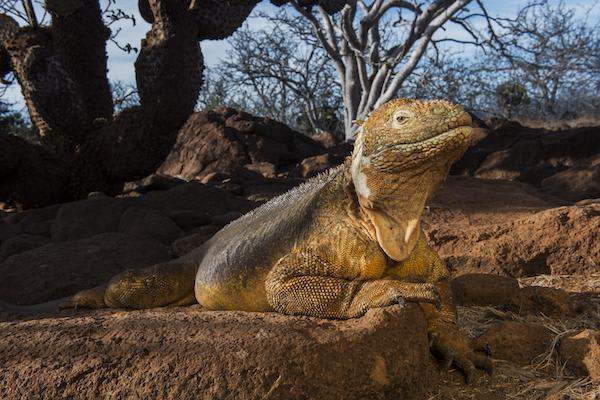
Disembarkation
AM: On the north side of Santa Cruz; behind the beach lies two small flamingo ponds where iguanas sunbathe, see coastal birds, Darwin finches, mockingbirds, and gulls, as well as interesting native vegetation like red and black mangrove, salt bushes. This beach is one of the main sea turtles' nesting sites in the Galapagos. A turtle can lay eggs 3 or 4 times per season with an average of 70 eggs each time. At this paradisiacal site, we will also find the remains of barges that sank a long time ago, when the United States Navy operated a base during World War II on Baltra Island. Local people modified the word barges to “Bachas”.
After the morning excursion, you will be assisted to Baltra airport for your flight to the mainland.
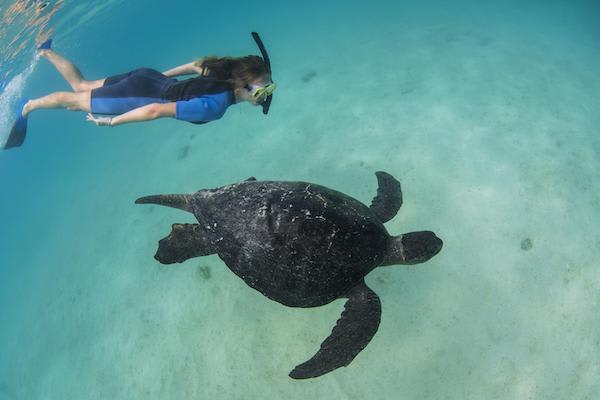
Accommodations
Social Areas
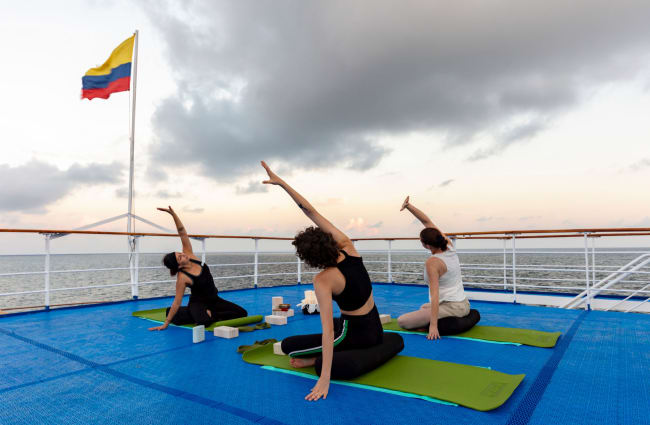
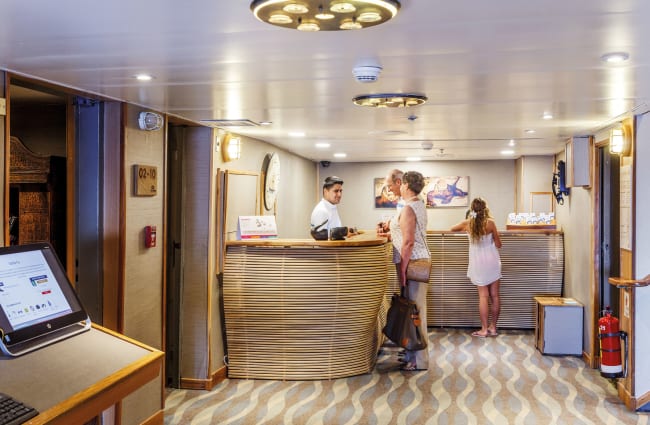
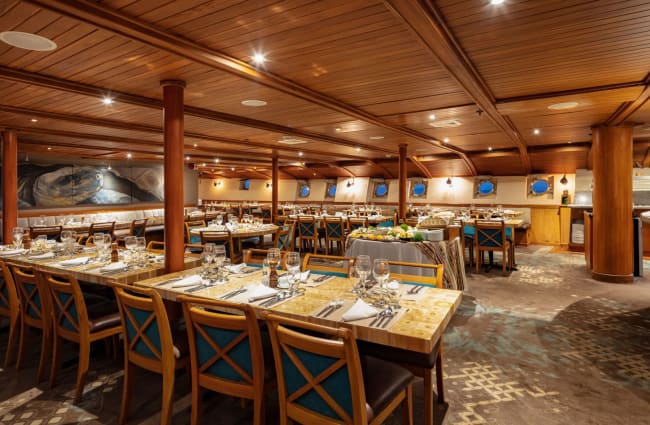
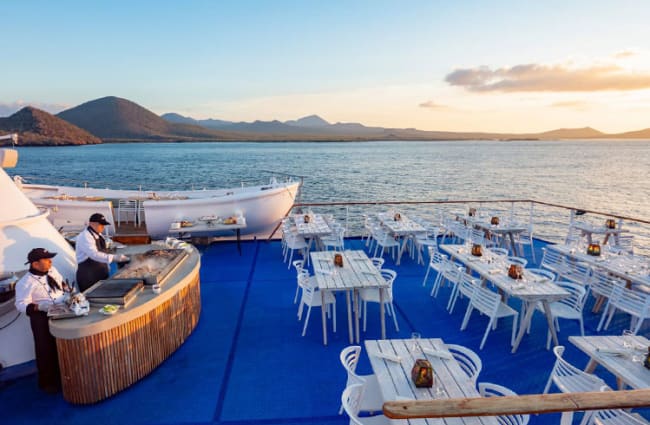
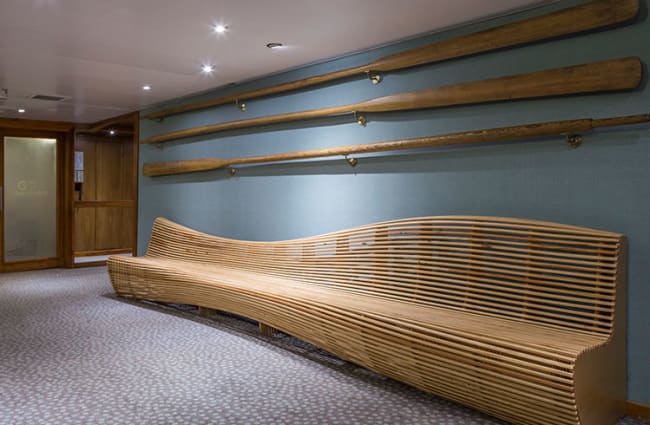
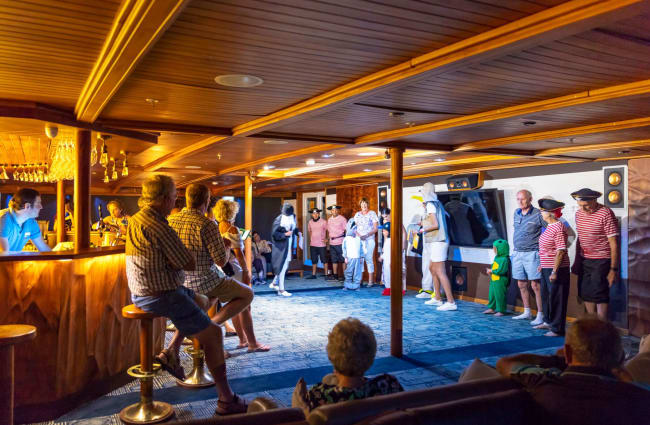
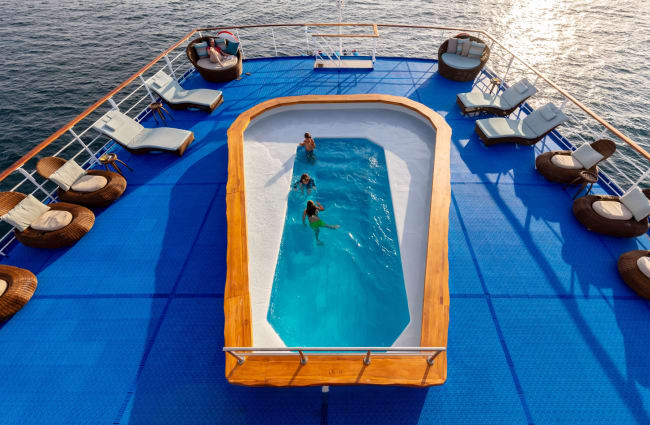
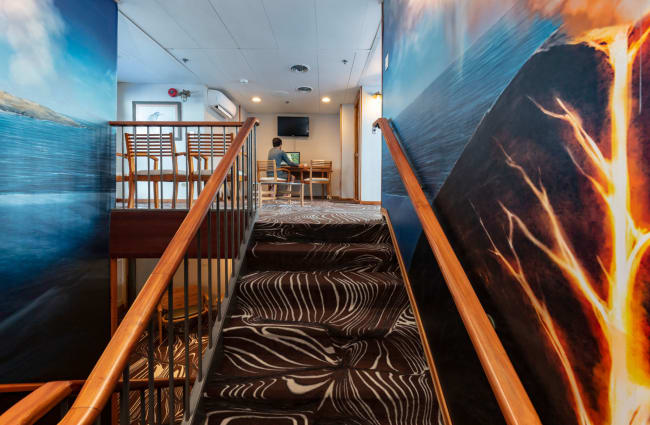

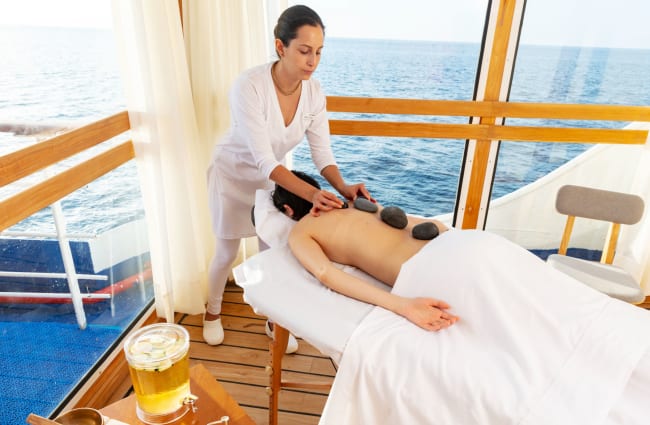

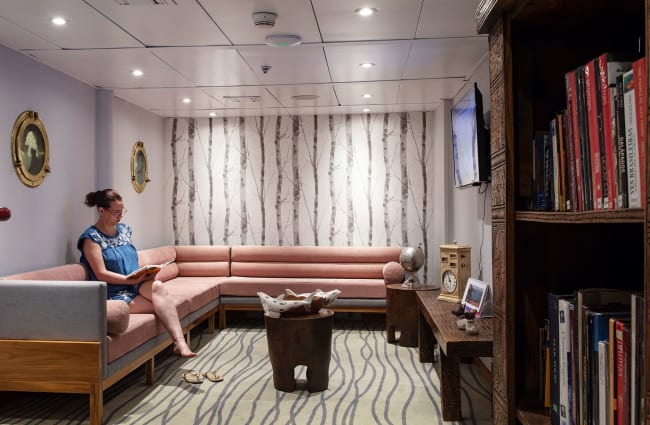
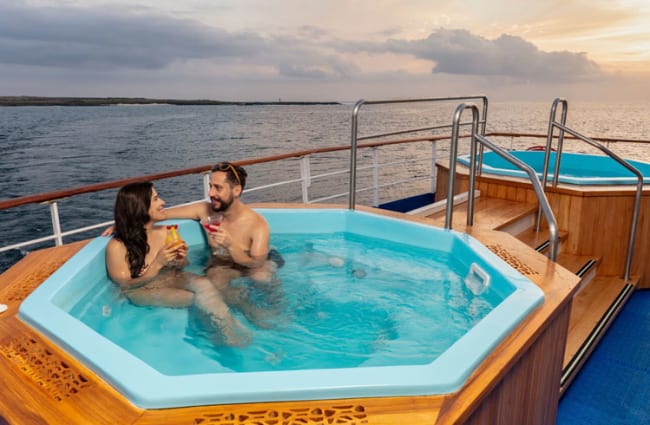
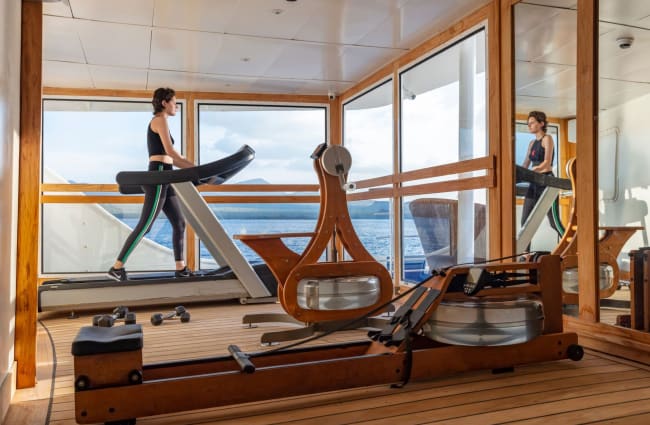
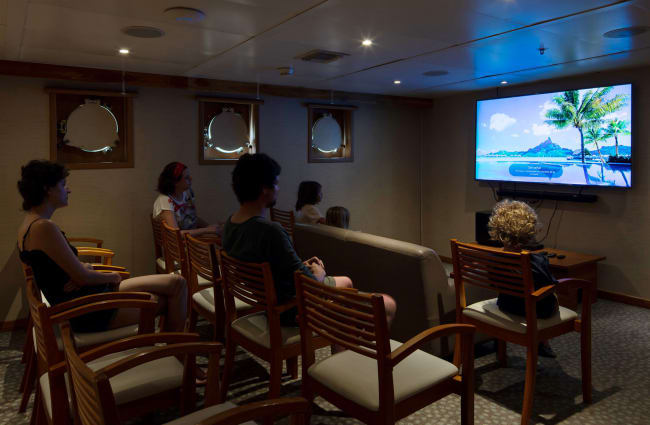
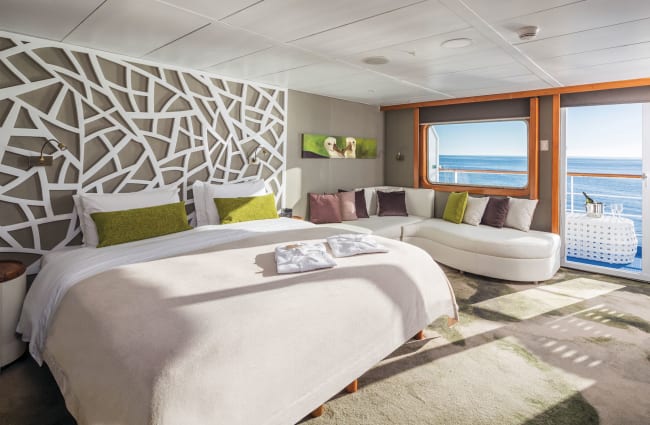
Suites & Cabins

Standard Interior
Revive yourself with a peaceful sleep in the firm and comfortable beds with fine linen in these suites. The private bathrooms are tastefully designed with a hairdryer, hot water, and other amenities. The room also comes with several electrical outlets for all your devices.
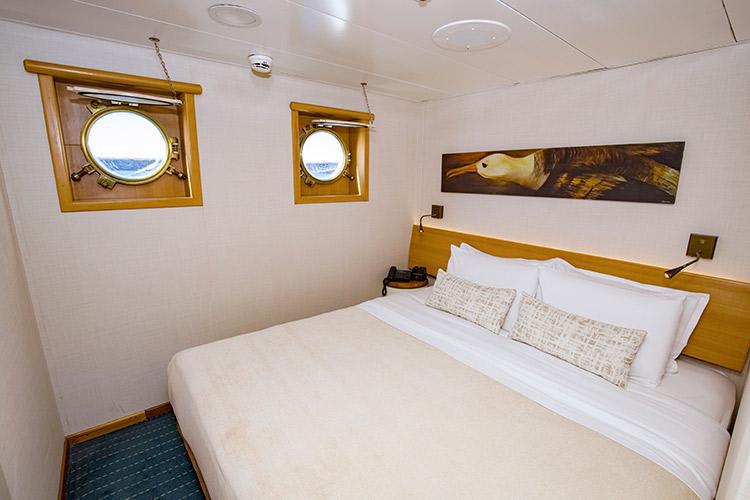
Standard Plus
These spacious cabins are exquisitely furnished with wall-to-wall carpeting and a music system. They feature a phone service for internal, local, and international calls, a sizeable closet, and a safety box. The porthole windows allow natural light to flow into the room.
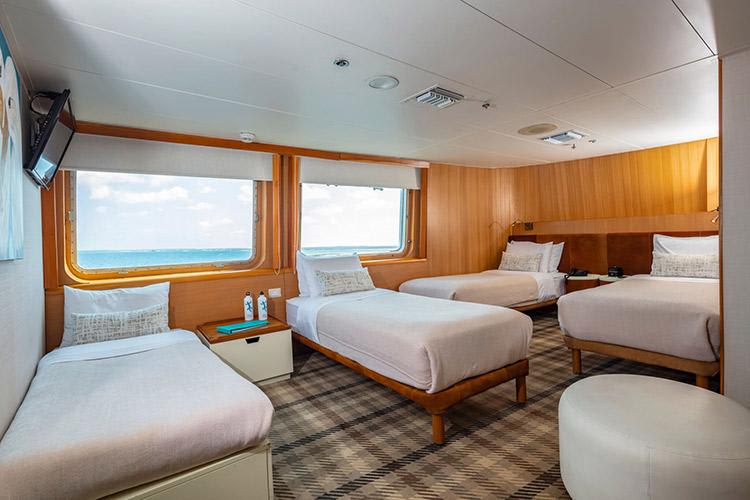


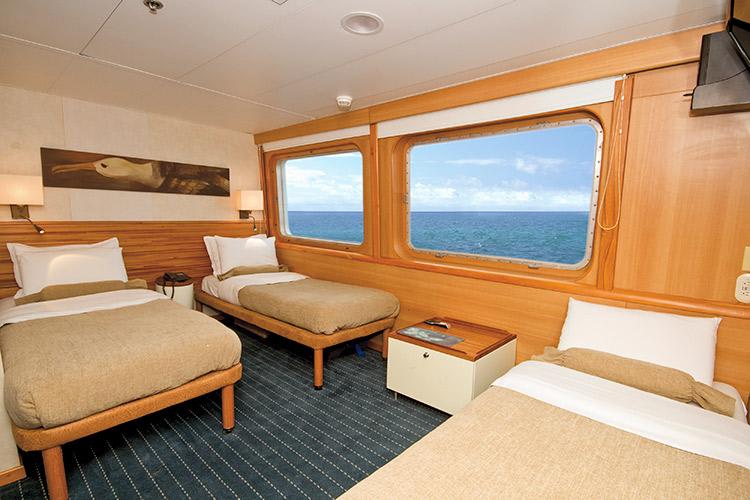
Junior
Enjoy a peaceful rest in the junior suites furnished with firm yet comfortable beds and fine linens. Some of the junior suites are interconnected, making them ideal for traveling families or friends. The private bathrooms are fully equipped with a hairdryer, toiletries, and hot water.
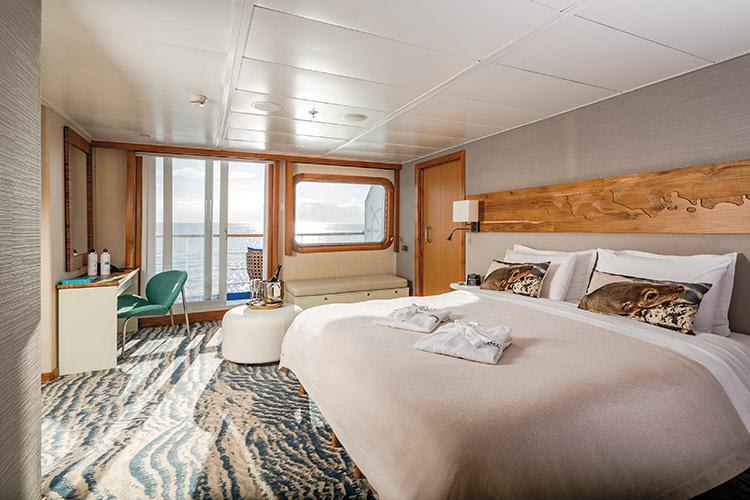
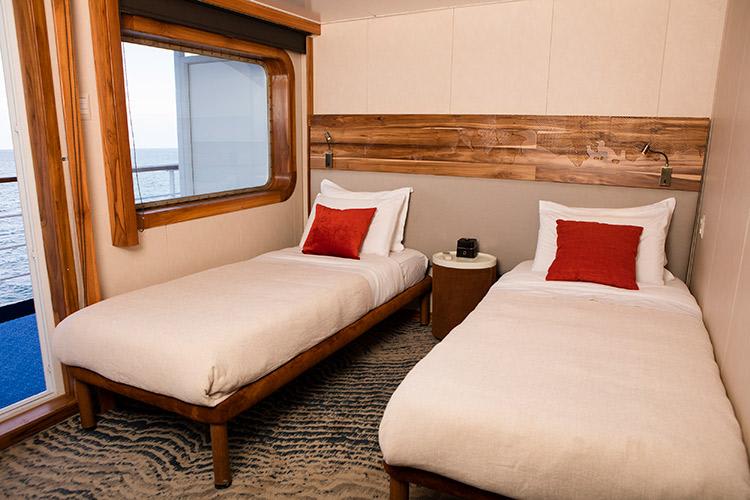
Balcony
Enjoy these spacious air-conditioned suites that come with a panoramic view of the ocean. Each suite comes with a private balcony and a fully equipped bathroom featuring a hairdryer and toiletries. The suites come with a minifridge for chilled drinks.
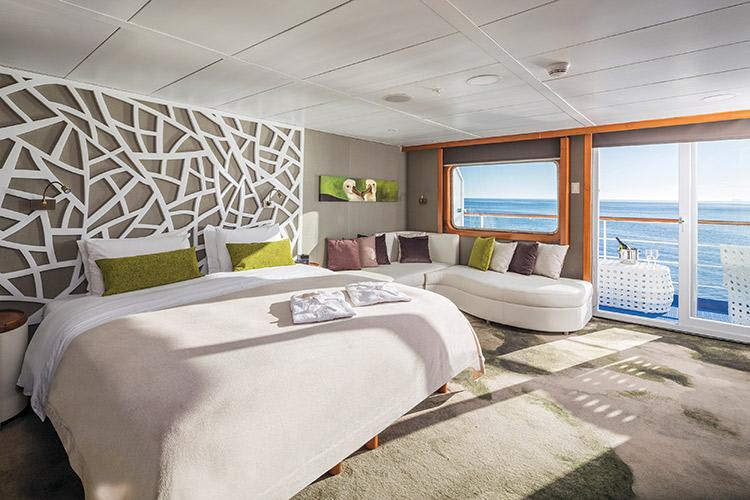
Legend Balcony
These suites are exclusively designed and feature wall-to-wall carpet, a sitting area, and a multimedia music system. The room features panoramic windows and a spacious balcony allowing you to enjoy the beautiful scenery from the comforts of your room or al fresco on the balcony.
Technical Information
Features
- Connecting cabins
- Cabins with balconies
- Air conditioning
- Pool / Jacuzzi
- Excercise room
- Massage room
- Lecture room
- Cinema
- WIFI available
- Kosher Meals
- Children's playroom
- Medical staff
Equipment
- Diving gear
- Snorkeling gear
- Wetsuits
- Kayaks / Canoes
- Yoga mats
Related Cruises
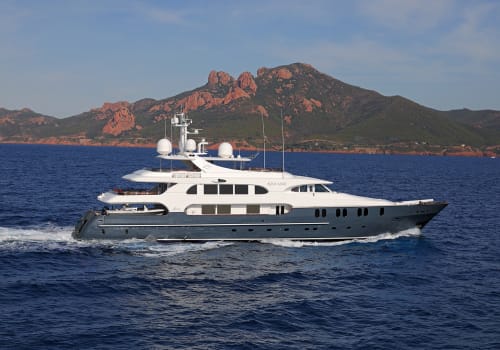
- Galapagos
- Ecuador
Aqua Mare

- Galapagos
- Ecuador
Cormorant II
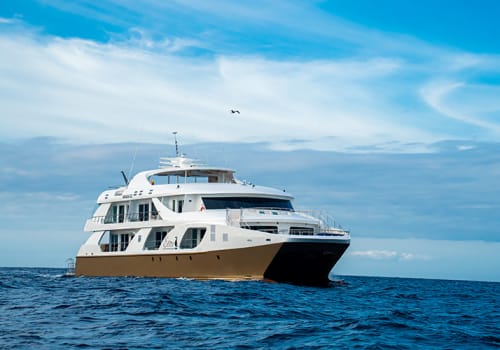
- Galapagos
- Ecuador
Elite

- Galapagos
- Ecuador
Galaxy Sirius
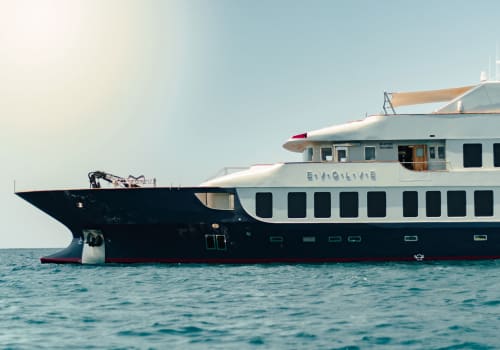
- Galapagos
- Ecuador
Origin, Theory & Evolve
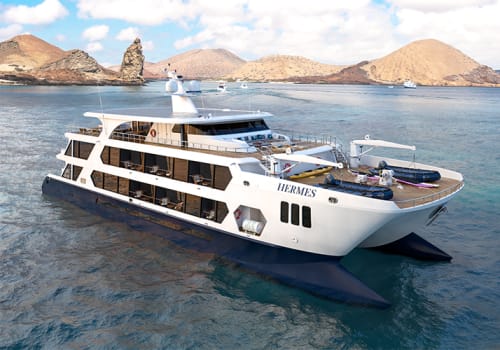
- Galapagos
- Ecuador
Hermes
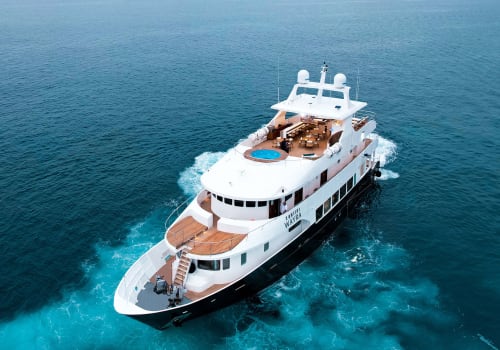
- Ecuador
- Costa Rica
Kontiki Wayra
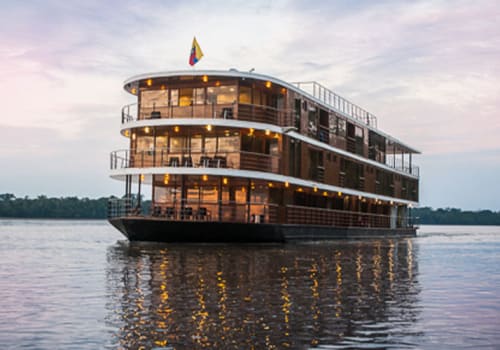
- Amazon
- Ecuador
Anakonda
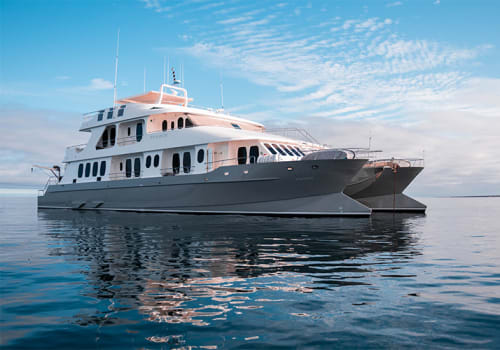
- Galapagos
- Ecuador
Alya
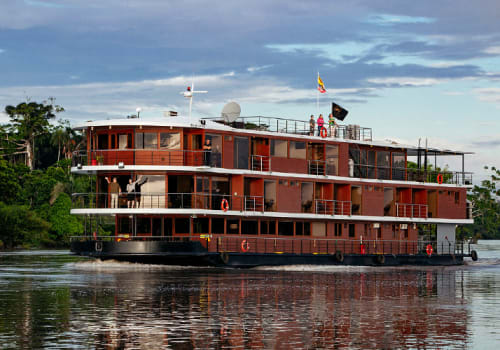
- Amazon
- Ecuador
Manatee Amazon Explorer

- Galapagos
- Ecuador
Endemic
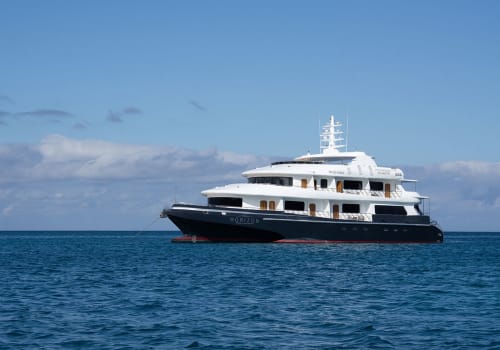
- Galapagos
- Ecuador
Galapagos Horizon
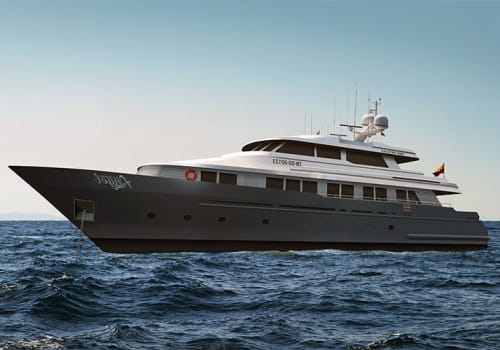
- Galapagos
- Ecuador

